Saturday, November 10, 2007
Are these the students who are leading a "peaceful" struggle to better Venezuela?
Unfortunately I have been busy lately and have therefore been a bit slow to fully digest the events that occured in Venezuela's main university last week.
Of course, if you just caught a peak of the mainstream media news coverage of it you know what happened - there was a protest of 80,000 students protesting a constitutional change that would make Chavez president forever, the students peacefully returned to their university where they were set upon by armed Chavista thugs who were riding around on motorcycles shooting at them, and a number of students were shot.
Sure sounds like Chavistas are rather thugish, doesn't it?
Then a funny thing happened: a lot of videos started coming out showing what really happened, so many that even lazy people like me started seeing them. For example here is one that people might really want to watch:
Note what do we see? The opposition students are all comfortably out in the open and don't seem to be afraid of anything. No one seems to be attacking them - rather we see THEM clearly attacking a building by setting fires, trying to knock down doors, and throwing rocks at the windows. We hear gunshots and we don't see any of the opposition students so much as flinch - I guess they weren't the ones being shot at. Also do note a number of these opposition students are wearing ski masks - I guess being masked isn't just a Chavista thing as some would have us believe.
Interestingly we also see some video of what was going on in the building - pro-Chavez students who had barricaded doors were sitting on floors trying to stay away from windows - hardly the actions of agressors.
Pretty clearly what we have here are a lot of opposition students being agressive and violent and going out of their way to attack Chavez supporters. We also have pro-Chavez students taking refuge in a building trying to stay out of harms way.
Funny, but that isn't exactly the impression of events that I got from the mass media here in the U.S. I guess they don't really give us "all the news that is fit to print" and remain "fair and balanced" as they like to claim they do. I suppose I should probably stop being so lazy and not let the U.S. mass media spoon feed me news even if I am busy sometimes.
|
Of course, if you just caught a peak of the mainstream media news coverage of it you know what happened - there was a protest of 80,000 students protesting a constitutional change that would make Chavez president forever, the students peacefully returned to their university where they were set upon by armed Chavista thugs who were riding around on motorcycles shooting at them, and a number of students were shot.
Sure sounds like Chavistas are rather thugish, doesn't it?
Then a funny thing happened: a lot of videos started coming out showing what really happened, so many that even lazy people like me started seeing them. For example here is one that people might really want to watch:
Note what do we see? The opposition students are all comfortably out in the open and don't seem to be afraid of anything. No one seems to be attacking them - rather we see THEM clearly attacking a building by setting fires, trying to knock down doors, and throwing rocks at the windows. We hear gunshots and we don't see any of the opposition students so much as flinch - I guess they weren't the ones being shot at. Also do note a number of these opposition students are wearing ski masks - I guess being masked isn't just a Chavista thing as some would have us believe.
Interestingly we also see some video of what was going on in the building - pro-Chavez students who had barricaded doors were sitting on floors trying to stay away from windows - hardly the actions of agressors.
Pretty clearly what we have here are a lot of opposition students being agressive and violent and going out of their way to attack Chavez supporters. We also have pro-Chavez students taking refuge in a building trying to stay out of harms way.
Funny, but that isn't exactly the impression of events that I got from the mass media here in the U.S. I guess they don't really give us "all the news that is fit to print" and remain "fair and balanced" as they like to claim they do. I suppose I should probably stop being so lazy and not let the U.S. mass media spoon feed me news even if I am busy sometimes.
|
Wednesday, November 07, 2007
New Orleans, in slow motion
If you’ve traveled west from Caracas towards the central Venezuelan cities of Maracay and Valencia you may have seen one of Venezuela’s largest fresh water lakes, the Lago de Valencia, or Valencia Lake. Then again, in spite of its size, you may not have seen it for reasons that will be apparent in a little while.
Here is a satellite photo of the lake:
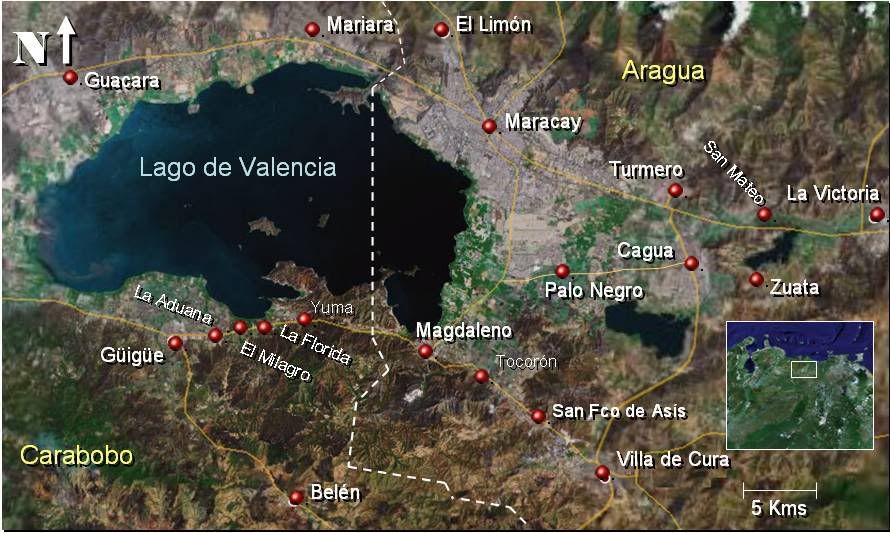
From east to west it is about 21 miles in length. Its deepest point is about 120 feet and has a dozens of rivers and creeks that feed into it.
Its most important geographical feature is that it has no natural outlet. That is, water flows in from rivers but only leaves the lake via evaporation under natural conditions. This is because the lake sits in a wide saucer shaped depression surrounded on all sides by higher land. To the north, as can be seen in the photograph, the lake is bordered by the rapidly growing city of Maracay. To the west the large industrial city of Valencia also lies in the same basin. The final significant geographical feature is a large mountain range that lies to the north of Maracay and the lake and separate both from the Caribbean sea much as the Avila separates Caracas from the sea.
So why the interest in some stupid little lake in the middle of Venezuela? Simple, this lake has a very interesting story to tell about how Venezuela has been mismanaged and its environment neglected for decades.
As I mentioned even people have driven by the lake many times may have never seen it. In fact that was the case with me. I have gone right by it, probably within a half mile of it, dozens of times on the way between Caracas and Barquisimeto without ever catching even a glimpse of it. It would be fair to say the lake is well hidden.
That is not an accident, it is by design. The lake is in effect a dead lake. Not that there is no life in it at all – there is. But no human being who values their health goes anywhere near it. Not to swim in it, boat on it, or even to walk along its shore. And if you value your life you certainly wouldn’t drink from it. Its waters are toxic. Yet there is more to the unfolding disaster that is Valencia Lake than just that.
For centuries the lake was actually shrinking. The reason is simple. There were small towns and cities all around it, they needed water, they took the water from the lake faster than it flowed in, and the lake shrank. Unfortunately, as those towns and cities grew and developed industry they needed a place to dump the human and industrial waste and as you might guess they dumped it into either into streams feeding the lake or directly in the lake itself. By the 1960s and 1970s the lake became very contaminated and unusable as either a source of recreation or of potable water. Tragically Venezuelans through indifference to the environment and mismanagement destroyed yet another of their natural treasures.
If the story of the Lago de Valencia ended there it would be bad enough. But it doesn’t. Generally when humans abuse their natural surroundings nature finds a way to fight back. And right now the Lago de Valencia is certainly exacting revenge for what has been done to it.
Here is how.
As the lake became contaminated it could no longer serve as a source of drinking water for the communities around it. Further the cities of Maracay and Valencia were growing rapidly so that even the rivers feeding the lake couldn’t supply enough clean water (and they have their own contamination problems but more on that later). The only solution was to bring water to those cities from elsewhere.
Large pipelines were built starting in 1978 to bring water in from Cojedes state which is further to the south. Two of these pipelines have been built bring in 11,500 liters of water per second to the Valencia basin from the dammed reservoirs Pao-Cachinche and Pao-Las Balsas. This water system, known as the aquaducto regional del centro, now meets the clean water needs of the region.
Yet given the very delicate balance of all natural systems it is often the case that changes which resolve one problem create yet another. Sure enough, that happened in this case.
All the water being piped in to the Valencia basin has to go somewhere after it is used. And given that it is in a saucer like basin where everything drains down the lake all this water eventually winds up the lake. Given that this lake has no outlets it is easy to see that a huge new volume of water being brought in every second of every day will quickly exceed the amount of water that leaves the lake through evaporation and he lake level will rise.
It has done just that. It is now rising approximately one foot per year. As it rises it is quickly expanding and flooding the flat low lying land that surrounds it. Thus via the law of unintended consequences an attempt to supply clean water to a growing population has turned the Valencia Lake into a monster that now threatens to consume those very same urban areas.
For the people in the southern part of the city of Maracay the monster is already at the door. For a person seeing it for the first time what is unfolding in southern Maracay is surreal and stunning. Although I have no pictures that can truly do it just here are some that at least provide some inkling:
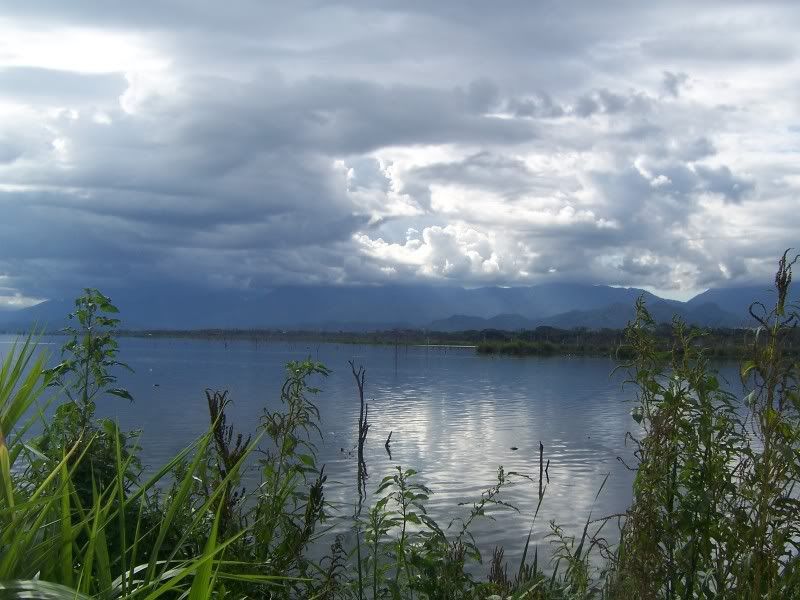

At very first glance the shimmering lake might seem normal and even somewhat attractive with the mountains in the background. But look closely and you’ll see signs of something amiss. Clearly visible are dead trees in the water. Those trees were only a few years ago on dry land – as the lake rose they became submerged and died. Also, in addition although they are hard to discern in these pictures you can also see telephone and utility polls. That is right, there used to be communities were the water is now. The remaining remnants are the occasional pole poking above the water.
Even more interesting than these lake scenes is the location from which these pictures were taken. I was actually standing on a 15 foot tall levee (yes, the same type of thing that was to protect New Orleans) that is holding back the water and keeping from flooding even more of the city.
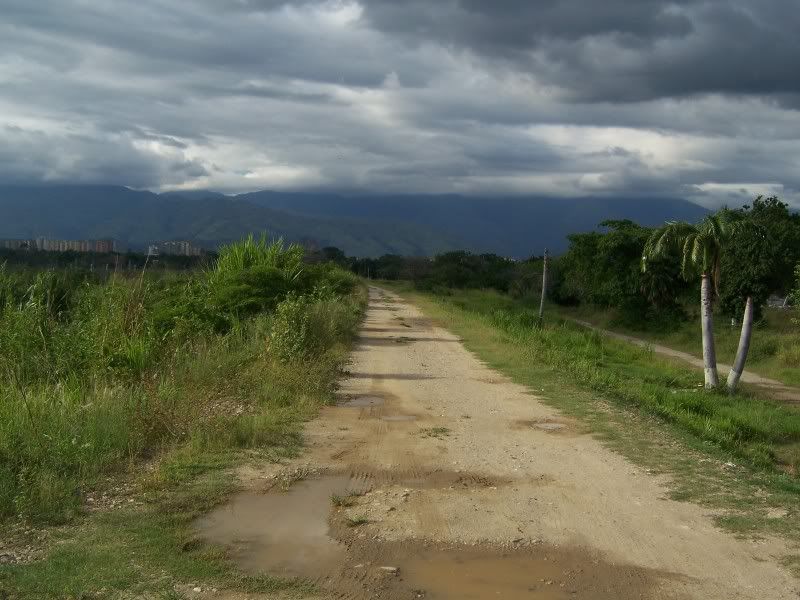
This is looking along the levee showing the road that runs along it. To the right would be the land being protected and to the left, out of view, is the lake. But earthen walls are not enough to keep the lake at bay. So they, just like New Orleans, having huge pumping stations to try to remove the water from behind the levee and put it back in the lake.

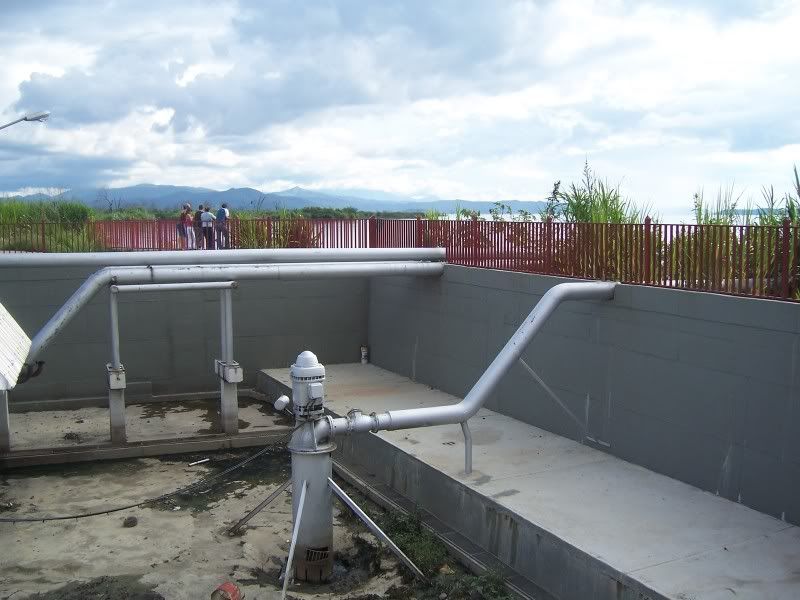
The people in the pictures are on top of the levee and the concrete foundation is at the level of the land behind the levee so from this you can get a sense of its size. These pumping stations have to run 24/7 removing water that seeps behind the levee, rain water that collects behind them, and rivers that used to outlet to the lake but now find this earthen wall blocking their way.
Oh and here is what the city looks like behind the levee:
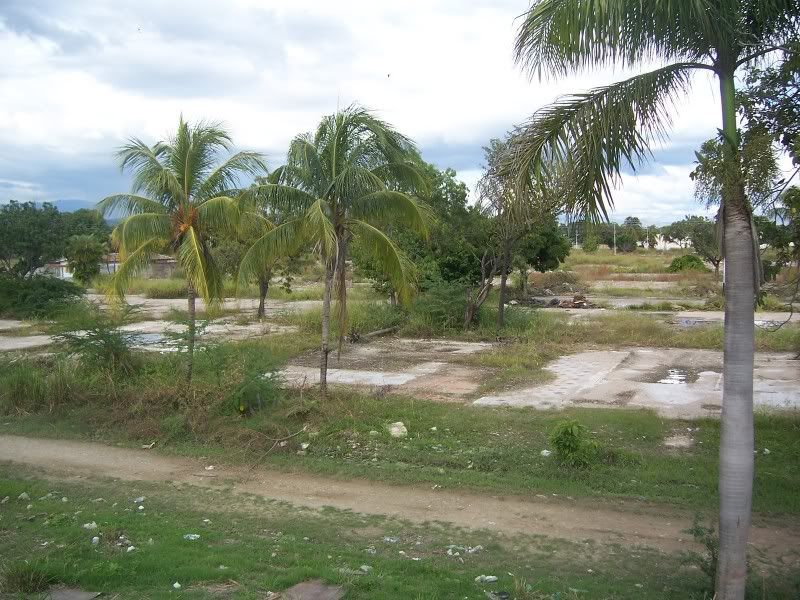
What, those are just vacant lots you say? Indeed they are. Surrounding the levee you see nothing but the former foundation of middle class homes that had to be demolished. The reason they were demolished is that even though the levee is offering some protection the water level has risen so high that water delivery and sewage systems no longer work. Without those systems working the area is uninhabitable.
This wasteland of destroyed communities is quite extensive – thousands of homes, stores and schools have already had to be destroyed so that you see acres and acres of this:
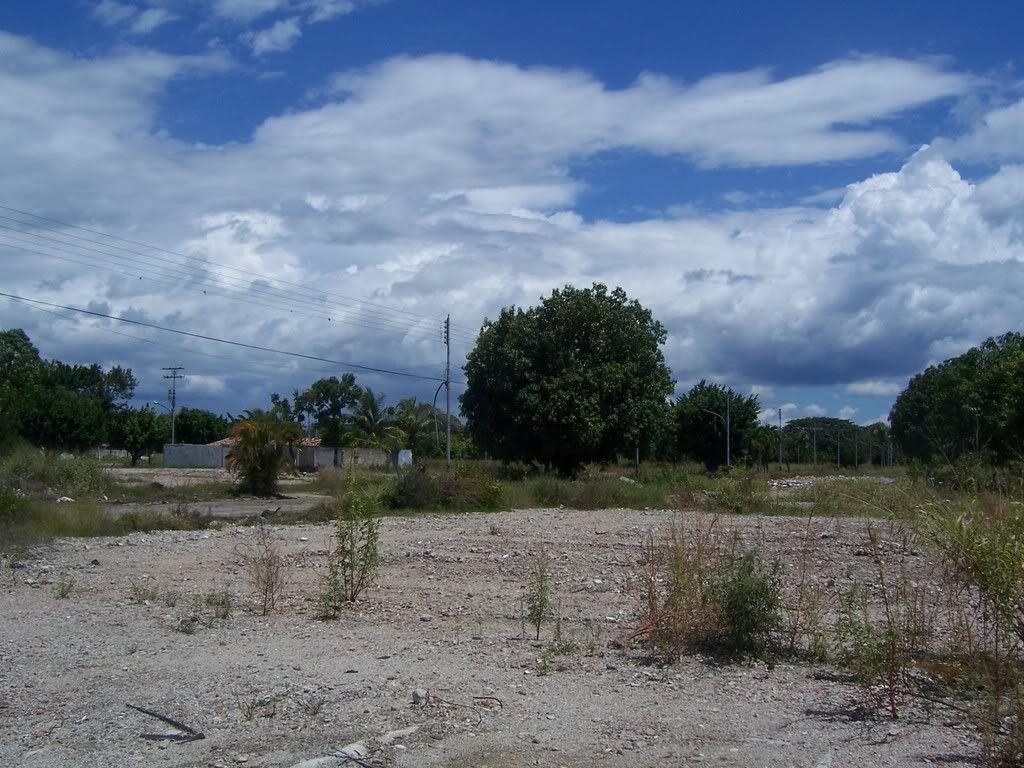

It is truly a pitiful and depressing site. But that is not the worst. The worst is that this devastation is growing each and every year. With the water level rising steadily each year more communities have to be abandoned by their residents and heavy equipment is brought in to level them. Each year approximately 500 more homes have be destroyed and while I was there I got to see heavy equipment in action:
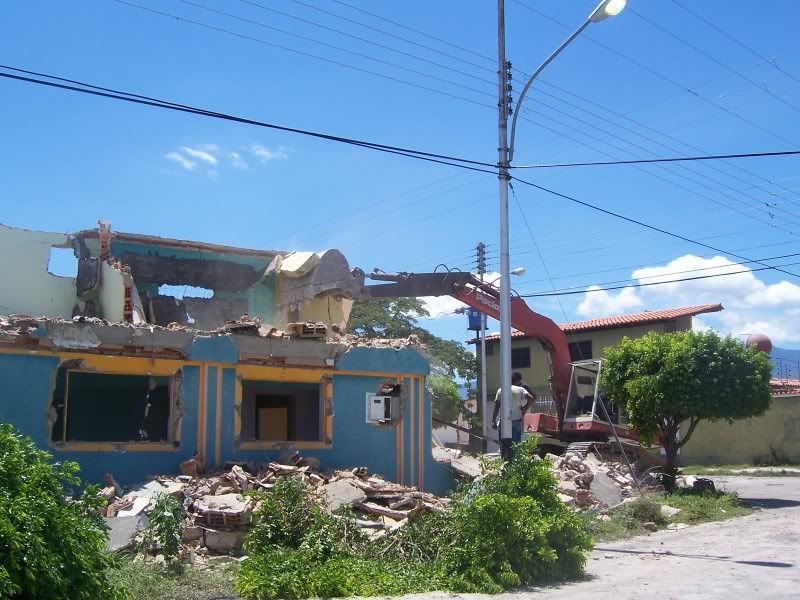
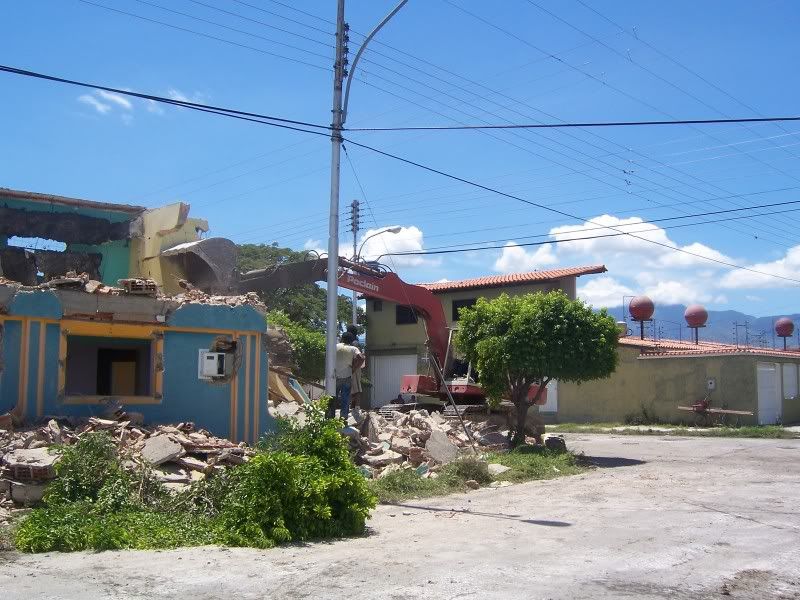
The destruction is incessant. It really is like what happened to New Orleans. The main difference is that here people are safely evacuated and there is no immediate loss of life. Yet unlike New Orleans in Maracay the destruction is anything but over – it keeps getting worse, day after day, week after week, month after month, and year after year.
In fact right around the corner from the above destruction the next victims – some rather nice middle class homes – awaited the same fate in the following days.

The owner of this home had just finished removing personally items and demolition was beginning. The owner spoke English and was eager to practice with a visitor so I got the full story. She had actually moved to this community from Caracas in 1976. People were encouraged to move there by the government to relieve congestion in Caracas and the people were happy to be moving into a comfortable middle class community.
In 1976 when she moved there the lake was not in their thoughts at all. It was 8 kilometers away. It never crossed their minds that a lake 8 kilometers away would one day destroy their homes and disrupt their lives.
Yet the irony doesn’t end there. Truth be told the woman wasn’t all that upset about what was happening. The reason is that all of these people who are losing their homes have been successfully able to sue the government and forced it to compensate them for their losses. Quite generously in fact. This woman as paid 350 million bolivares in compensation and she was moving back to live in a new apartment she bought in Caracas.
The reason people were able to make a claim against the government was because it was the government which had approved, even encouraged, them moving there in the first place. Not the Chavez government of course. It was the governments of Carlos Andres Perez, Jaime Lusinchi and Rafael Caldera that thought it was a good idea to move people there. The Chavez government just gets the pleasure of paying to clean up this whole mess.
The house right next door had already been knocked down:
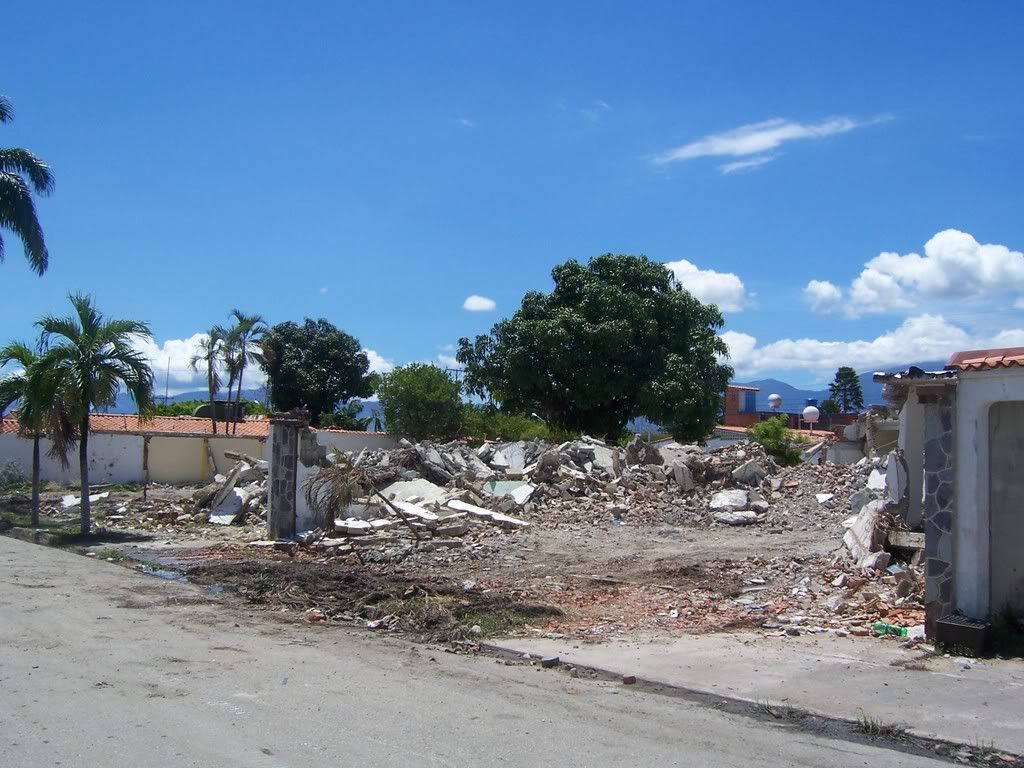
The house across the street was still being vacated and awaited its fate later in the week:
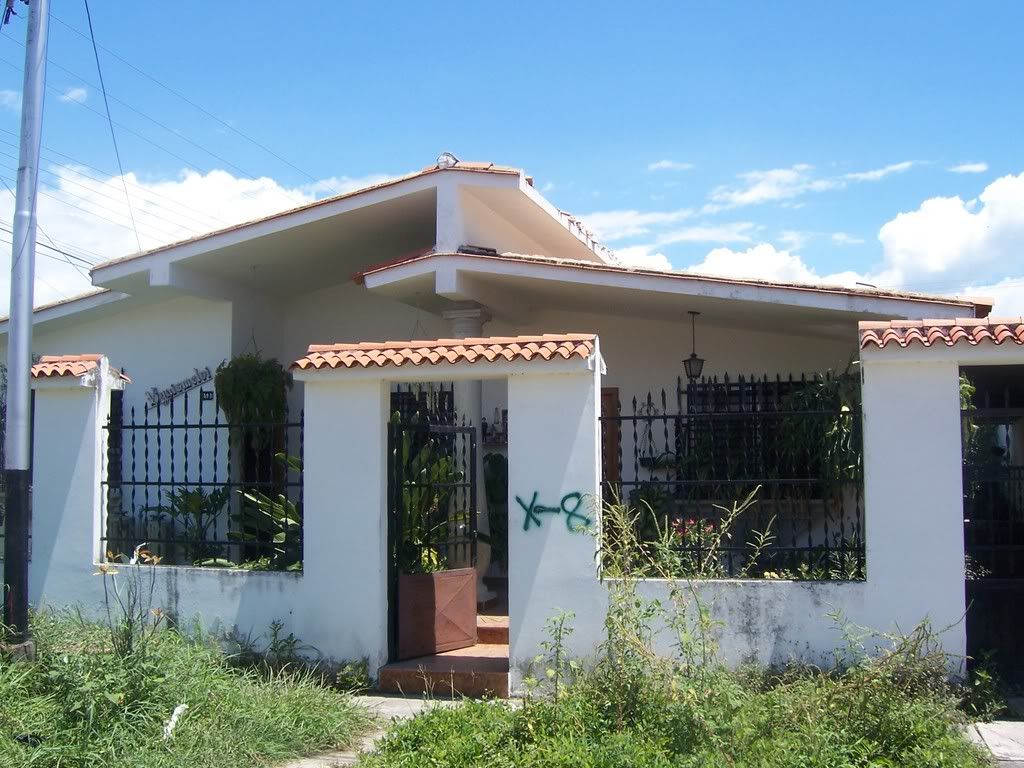
Note the “W-8” spray painted on the house (again, just like you know where). That tells the demolition crews that this house has been paid off by the government and is ready for demolition. You can drive by block after block where all the homes have these numbers spray painted on them making them ready to be turned into a pile of rubble just like this.
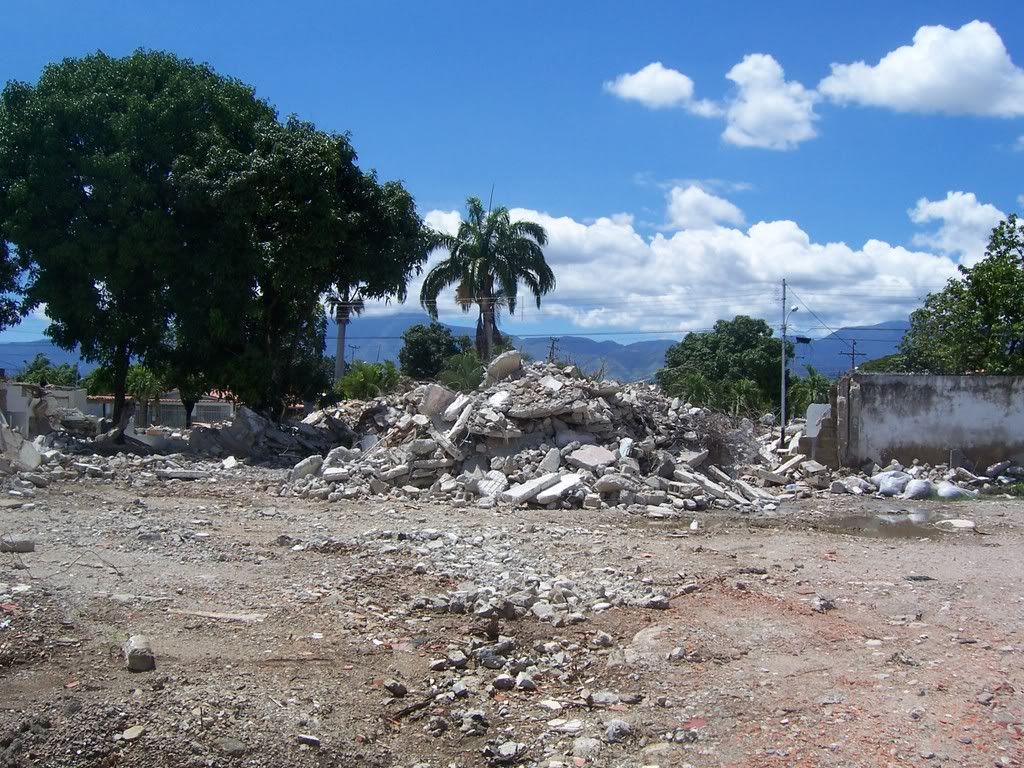
By the way, for some people this destruction actually can’t come soon enough:
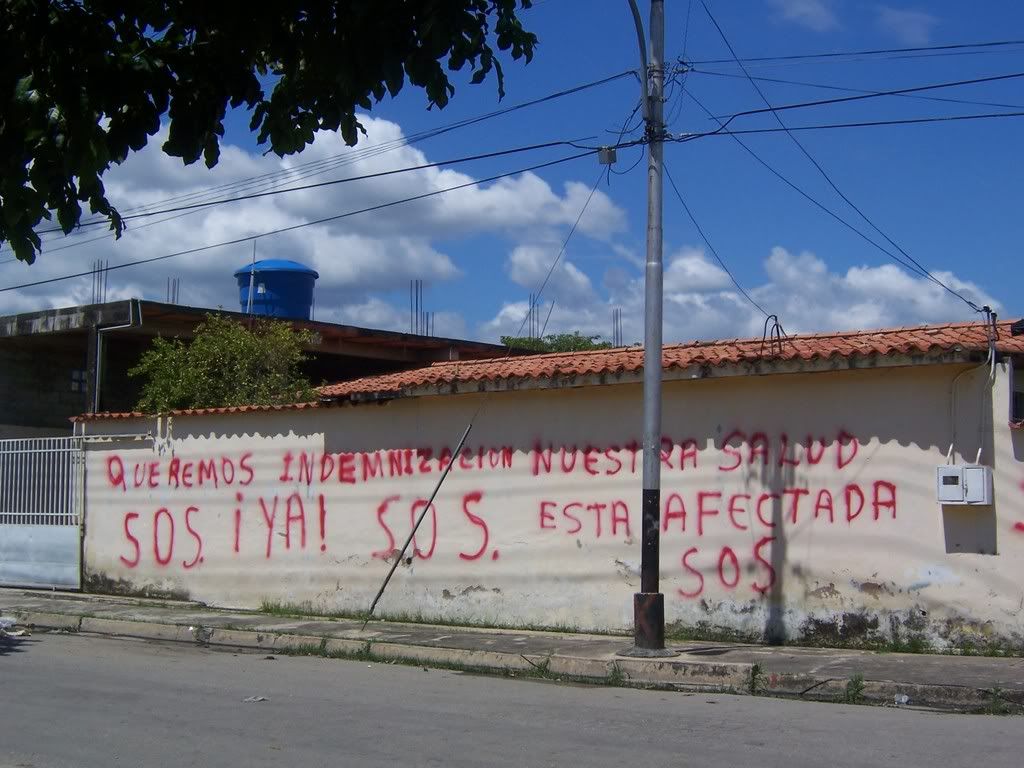
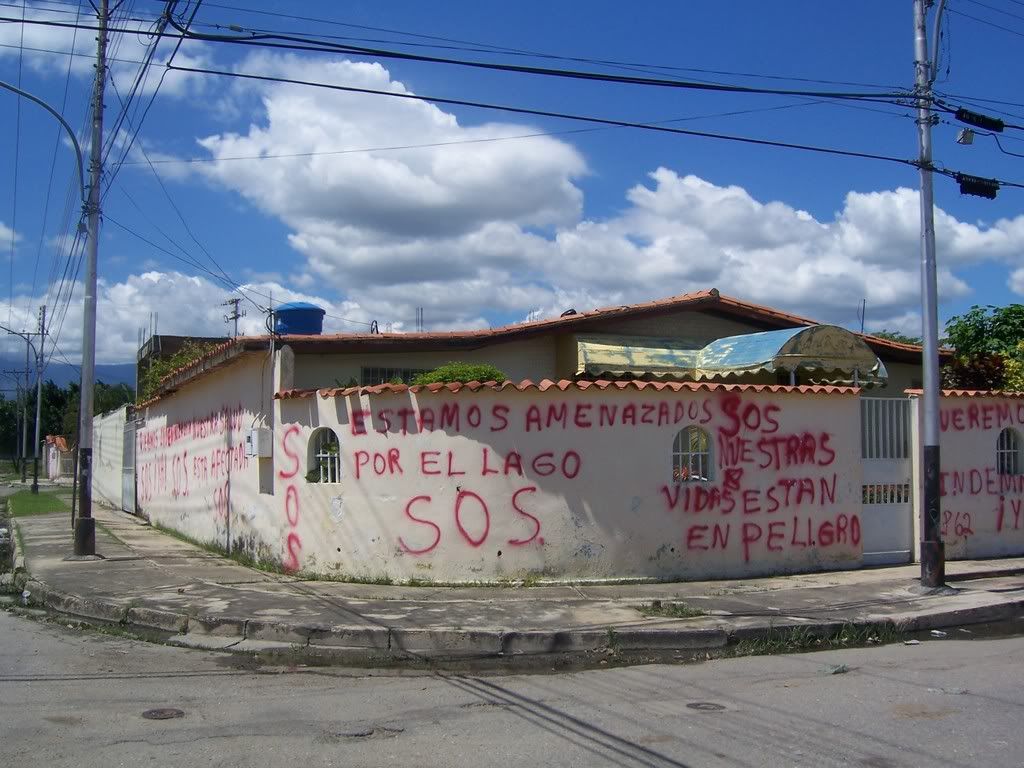
This house with “S.O.S.” painted all over for it complains that the lake is “making us sick” and demands compensation to move elsewhere. This house was actually not that far from where the homes were already being destroyed and was probably no more than a year away from being destroyed itself. This house right next to it (and you can see these are actually very nice homes) already has its spray painted number sealing its fate:
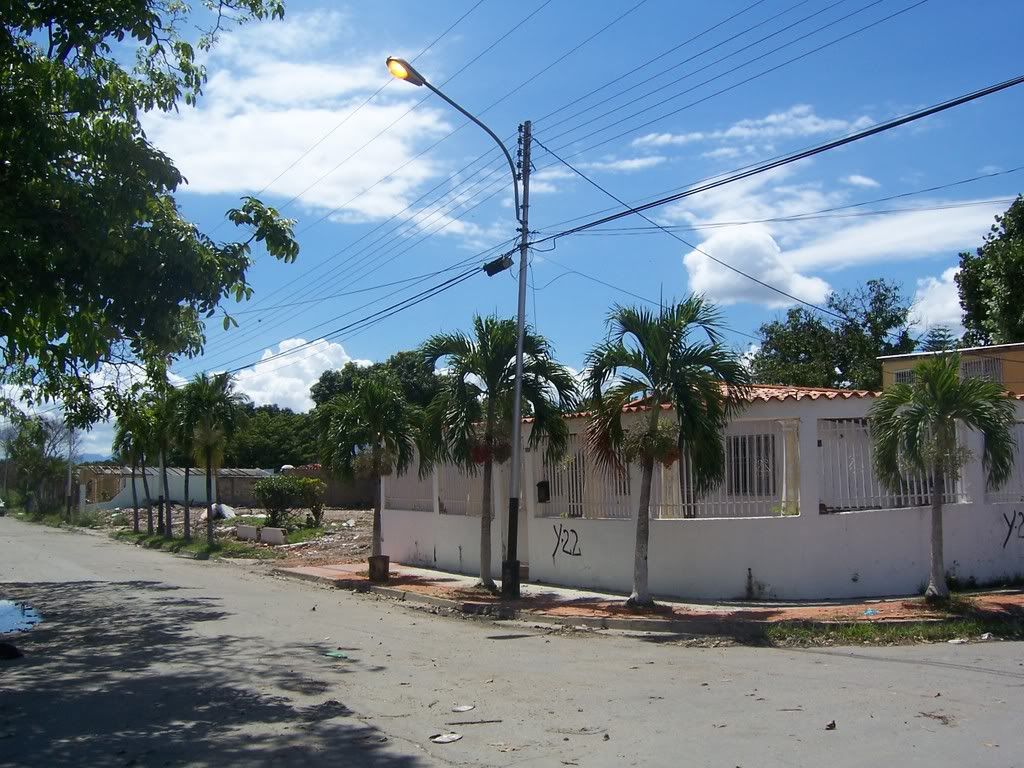
To get sense of proportion you should note this home was about 20 blocks away from the levee.
Driving around this scene of massive destruction you also see many partly flooded streets which show why they are in a hurry to evacuate these areas:
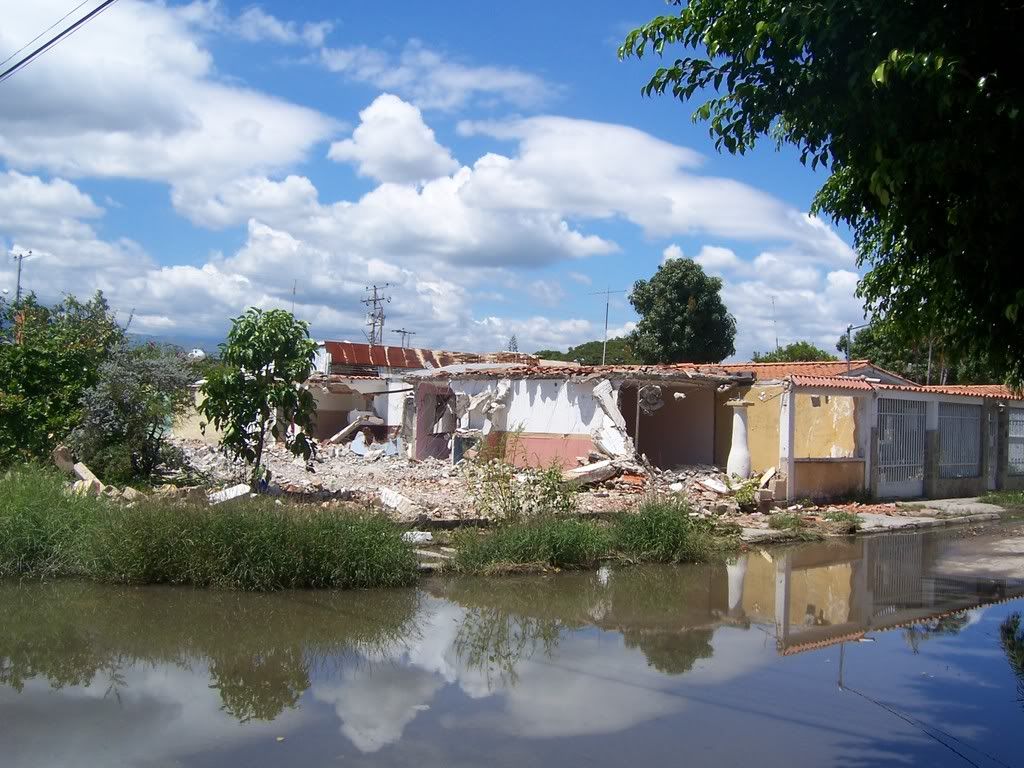
It needs to be kept in mind that this is but one section of the city. Later I visited other parts of Maracay along the lake and the exact same process was playing out there.
Slowly but surely a city of almost a million people is being destroyed by decades of poor planning and neglect.
What is being done about this? Can Maracay be saved? Yes it can and while there is no immediate solution at hand there are a couple proposals that could reverse this process.
One proposed solution is to pump water out of the lake to some other place. The problem is, because the lake is in a big depression you have to pump it a long distance to get it some place where it won’t simply run right back into the lake. If fact the closest place to pump it, and the one actually proposed, is over the mountains running north of Maracay along the coast. Of course that would still be quite a feat to do that – those mountains are every bit as big as the Avila mountain range in Caracas and pumping the water up and over them would not be easy.
But here is the really, really bad part of that plan and the reason we should all hope it is never implemented. The water would be pumped to the top of the mountains and simply dumped on the other side. This highly contaminated water would then run down the mountain streams through one of Venezuela’s most important national parks, the world famous and incredibly bio-diverse Parque Nacional Henri Pittier, and end up in the waters of some of its most pristine beaches. In other words, the ecological disaster that is Lake Valencia would be spread to an irreplaceable area of amazing and unique biological diversity.
All I have to say is that if that insane plan is given the green light then GreenPeace will need to get down their with some explosives and start blowing up those pumping stations and pipelines before they ever enter use.
The alternative to that cheap but devastating plan is quite ingenious, if possibly a good bit more expensive. It would involve constructing an outlet from the lake into an underground pipeline. It would be much like the drains on bathroom sinks that ensure they never overflow – it is a permanent outlet and as soon as the water reaches that level it flows into the drain (or pipeline) and does not rise any higher. This would completely stop the level of the lake from rising and it could be placed at any level that they desired the lake remain at permanently.
The water still has to go somewhere and that part of the solution is also ingenious. A tunnel to carry the water would be drilled underneath the mountains and would carry the excess lake water to the sea. Because the lake is more than 200 meters above sea level the tunnel would have a constant downward slope and no pumping would be necessary – it would be an entirely gravity operated drainage system.
It therefore has the huge advantage that once built it would cost almost nothing to operate. In fact its proponents thought that a concession to a private company to install and run a small electricity generating turbine might help generate revenue to partially offset what would obviously be an expensive construction.
Finally, the tunnel would extend out into the sea for two kilometers before discharging the water. The water currents have been studied and would from that point carry the contaminated water out to sea (lets hope they got that study right or you can kiss the beaches of Choroni goodbye).
This would seem to be both a very elegant and robust solution to the problem that Maracay confronts. But due to its high cost it is not known when this will be built, or even if it ever will. Unfortunately decades of neglect and even arrogance towards the environment are now exacting a very high price which will have to be paid for years or even decades.
Of course, even if this ingenious plan is implemented the problem will not be completely solved. Valencia Lake will still be an unusable toxic stew even if it is no longer growing (actually it will probably be an even more concentrated and hence more poisonous stew as the chemicals and sewage will be more concentrated). To solve that problem is no less daunting and undertaking as it would require that all the industry located around the lake dispose of their wastes properly instead of simply dumping them in the lake. Given that this is one of the most industrialized areas of Venezuela that is probably no small task. At this point the Environment Ministry has yet to even finish a full census of all the industrial establishments there and what kind of wastes they generate.
Also, the wastes from the two million people living around the lake would have to stop being dumped into it and its tributaries as raw sewage. Work is further along in this regard and I was able to see some of it.
Several sewage treatment plants have already been constructed. However, for them to be effective piping has to be installed to bring the sewage that is currently dumped straight into rivers to the treatment plants. That work is already under way with dozens of kilometers of piping having been installed. Here we can see some of what they are up against:
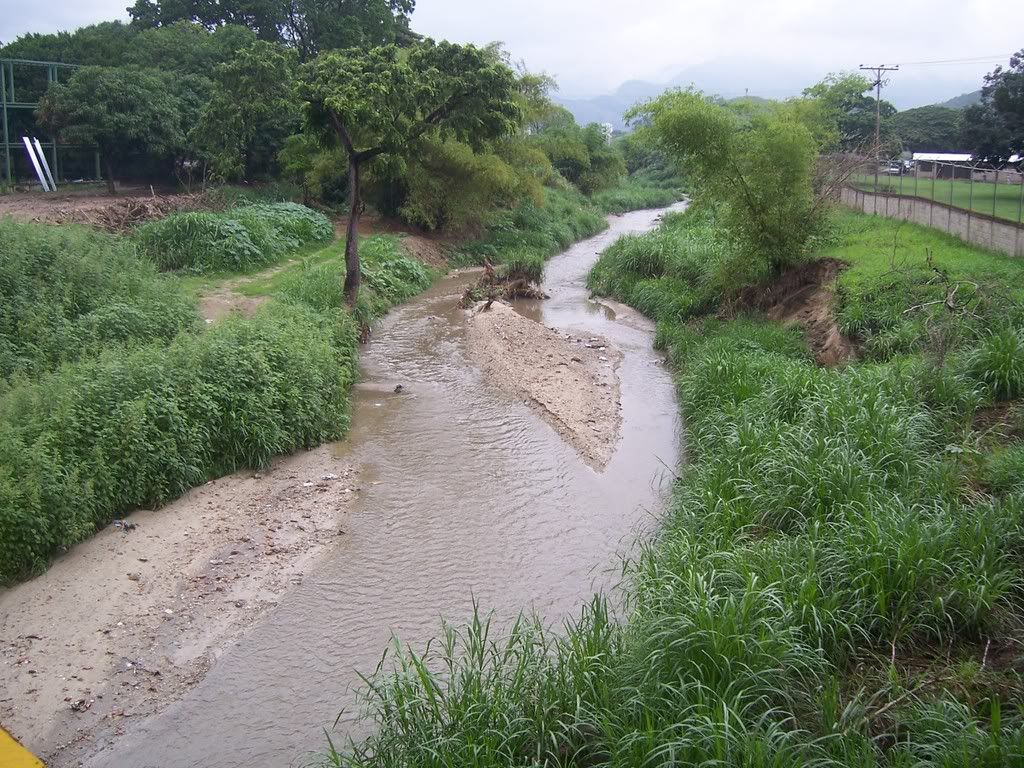
If you look carefully you can see a mostly submerged concrete tube to the left of the sandbar in the river. This pipe is discharging waste directly into the river which in turn empties a short distance later into the lake. Pipeline is being installed along the length of this and other rivers and connected to these existing pipes to intercept their waste before it enters the river and carry it to the treatment plant. Of course, this costs money (over a million dollars in fact) as this sign points out:
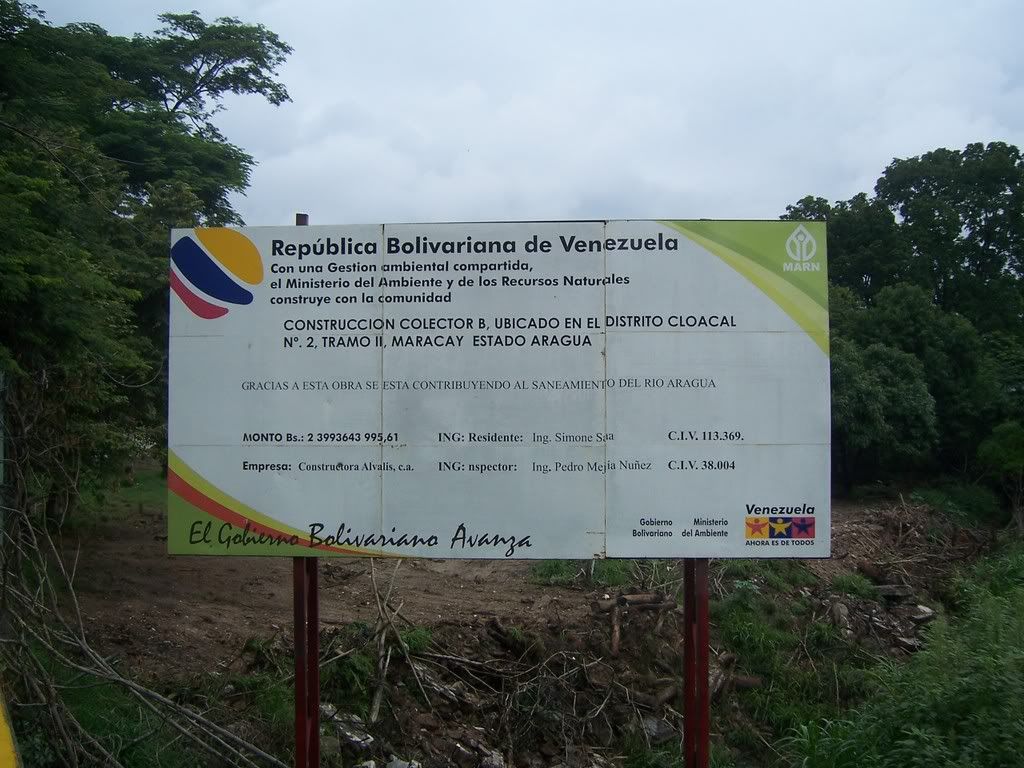
Through these measures it is hoped that the level of contamination can be reduced. But no one should expect to go swimming in this lake, much less drink its water, any time soon. It will remain contaminated for decades to come no matter what it done.
In fact, so extreme is the level of contamination that it even effects the plans for any recovered lands when the lake level is reduced. When the level of the lake is lowered many square kilometers of land will become available. However, the toxic chemicals from the water are now firmly embedded in the soil beneath the water making the land itself hazardous to human being and animals. The responsible thing they can think of to do with it is grow sugar cane on it and only use that sugar cane to make ethanol fuel. Absolutely nothing can be grown on that land that would ever enter the human food chain.
The situation with Lake Valencia is truly a disaster and unfortunately it has yet to fully run its course. This blogger has never been much involved with environmental issues but seeing this devastation first hand truly moved me. It showed in a very powerful way how when we abuse our natural surrounding the environment will in turn exact a price on us - sometimes with a vengeance. Humans simply can’t act with such disregard for their surroundings as Venezuelans clearly have for decades.
And there is no use finger pointing and trying to pass blame. Venezuela as a society is responsible for this mess (of which Lake Valencia is only ONE example) and they as a society will have to pay the price to fix this. If you walk through the southern part of the city of Maracay it will be made clear they can no longer just ignore it. That strategy of the past few decades will work no more.
|
Here is a satellite photo of the lake:

From east to west it is about 21 miles in length. Its deepest point is about 120 feet and has a dozens of rivers and creeks that feed into it.
Its most important geographical feature is that it has no natural outlet. That is, water flows in from rivers but only leaves the lake via evaporation under natural conditions. This is because the lake sits in a wide saucer shaped depression surrounded on all sides by higher land. To the north, as can be seen in the photograph, the lake is bordered by the rapidly growing city of Maracay. To the west the large industrial city of Valencia also lies in the same basin. The final significant geographical feature is a large mountain range that lies to the north of Maracay and the lake and separate both from the Caribbean sea much as the Avila separates Caracas from the sea.
So why the interest in some stupid little lake in the middle of Venezuela? Simple, this lake has a very interesting story to tell about how Venezuela has been mismanaged and its environment neglected for decades.
As I mentioned even people have driven by the lake many times may have never seen it. In fact that was the case with me. I have gone right by it, probably within a half mile of it, dozens of times on the way between Caracas and Barquisimeto without ever catching even a glimpse of it. It would be fair to say the lake is well hidden.
That is not an accident, it is by design. The lake is in effect a dead lake. Not that there is no life in it at all – there is. But no human being who values their health goes anywhere near it. Not to swim in it, boat on it, or even to walk along its shore. And if you value your life you certainly wouldn’t drink from it. Its waters are toxic. Yet there is more to the unfolding disaster that is Valencia Lake than just that.
For centuries the lake was actually shrinking. The reason is simple. There were small towns and cities all around it, they needed water, they took the water from the lake faster than it flowed in, and the lake shrank. Unfortunately, as those towns and cities grew and developed industry they needed a place to dump the human and industrial waste and as you might guess they dumped it into either into streams feeding the lake or directly in the lake itself. By the 1960s and 1970s the lake became very contaminated and unusable as either a source of recreation or of potable water. Tragically Venezuelans through indifference to the environment and mismanagement destroyed yet another of their natural treasures.
If the story of the Lago de Valencia ended there it would be bad enough. But it doesn’t. Generally when humans abuse their natural surroundings nature finds a way to fight back. And right now the Lago de Valencia is certainly exacting revenge for what has been done to it.
Here is how.
As the lake became contaminated it could no longer serve as a source of drinking water for the communities around it. Further the cities of Maracay and Valencia were growing rapidly so that even the rivers feeding the lake couldn’t supply enough clean water (and they have their own contamination problems but more on that later). The only solution was to bring water to those cities from elsewhere.
Large pipelines were built starting in 1978 to bring water in from Cojedes state which is further to the south. Two of these pipelines have been built bring in 11,500 liters of water per second to the Valencia basin from the dammed reservoirs Pao-Cachinche and Pao-Las Balsas. This water system, known as the aquaducto regional del centro, now meets the clean water needs of the region.
Yet given the very delicate balance of all natural systems it is often the case that changes which resolve one problem create yet another. Sure enough, that happened in this case.
All the water being piped in to the Valencia basin has to go somewhere after it is used. And given that it is in a saucer like basin where everything drains down the lake all this water eventually winds up the lake. Given that this lake has no outlets it is easy to see that a huge new volume of water being brought in every second of every day will quickly exceed the amount of water that leaves the lake through evaporation and he lake level will rise.
It has done just that. It is now rising approximately one foot per year. As it rises it is quickly expanding and flooding the flat low lying land that surrounds it. Thus via the law of unintended consequences an attempt to supply clean water to a growing population has turned the Valencia Lake into a monster that now threatens to consume those very same urban areas.
For the people in the southern part of the city of Maracay the monster is already at the door. For a person seeing it for the first time what is unfolding in southern Maracay is surreal and stunning. Although I have no pictures that can truly do it just here are some that at least provide some inkling:


At very first glance the shimmering lake might seem normal and even somewhat attractive with the mountains in the background. But look closely and you’ll see signs of something amiss. Clearly visible are dead trees in the water. Those trees were only a few years ago on dry land – as the lake rose they became submerged and died. Also, in addition although they are hard to discern in these pictures you can also see telephone and utility polls. That is right, there used to be communities were the water is now. The remaining remnants are the occasional pole poking above the water.
Even more interesting than these lake scenes is the location from which these pictures were taken. I was actually standing on a 15 foot tall levee (yes, the same type of thing that was to protect New Orleans) that is holding back the water and keeping from flooding even more of the city.

This is looking along the levee showing the road that runs along it. To the right would be the land being protected and to the left, out of view, is the lake. But earthen walls are not enough to keep the lake at bay. So they, just like New Orleans, having huge pumping stations to try to remove the water from behind the levee and put it back in the lake.


The people in the pictures are on top of the levee and the concrete foundation is at the level of the land behind the levee so from this you can get a sense of its size. These pumping stations have to run 24/7 removing water that seeps behind the levee, rain water that collects behind them, and rivers that used to outlet to the lake but now find this earthen wall blocking their way.
Oh and here is what the city looks like behind the levee:

What, those are just vacant lots you say? Indeed they are. Surrounding the levee you see nothing but the former foundation of middle class homes that had to be demolished. The reason they were demolished is that even though the levee is offering some protection the water level has risen so high that water delivery and sewage systems no longer work. Without those systems working the area is uninhabitable.
This wasteland of destroyed communities is quite extensive – thousands of homes, stores and schools have already had to be destroyed so that you see acres and acres of this:


It is truly a pitiful and depressing site. But that is not the worst. The worst is that this devastation is growing each and every year. With the water level rising steadily each year more communities have to be abandoned by their residents and heavy equipment is brought in to level them. Each year approximately 500 more homes have be destroyed and while I was there I got to see heavy equipment in action:


The destruction is incessant. It really is like what happened to New Orleans. The main difference is that here people are safely evacuated and there is no immediate loss of life. Yet unlike New Orleans in Maracay the destruction is anything but over – it keeps getting worse, day after day, week after week, month after month, and year after year.
In fact right around the corner from the above destruction the next victims – some rather nice middle class homes – awaited the same fate in the following days.

The owner of this home had just finished removing personally items and demolition was beginning. The owner spoke English and was eager to practice with a visitor so I got the full story. She had actually moved to this community from Caracas in 1976. People were encouraged to move there by the government to relieve congestion in Caracas and the people were happy to be moving into a comfortable middle class community.
In 1976 when she moved there the lake was not in their thoughts at all. It was 8 kilometers away. It never crossed their minds that a lake 8 kilometers away would one day destroy their homes and disrupt their lives.
Yet the irony doesn’t end there. Truth be told the woman wasn’t all that upset about what was happening. The reason is that all of these people who are losing their homes have been successfully able to sue the government and forced it to compensate them for their losses. Quite generously in fact. This woman as paid 350 million bolivares in compensation and she was moving back to live in a new apartment she bought in Caracas.
The reason people were able to make a claim against the government was because it was the government which had approved, even encouraged, them moving there in the first place. Not the Chavez government of course. It was the governments of Carlos Andres Perez, Jaime Lusinchi and Rafael Caldera that thought it was a good idea to move people there. The Chavez government just gets the pleasure of paying to clean up this whole mess.
The house right next door had already been knocked down:

The house across the street was still being vacated and awaited its fate later in the week:

Note the “W-8” spray painted on the house (again, just like you know where). That tells the demolition crews that this house has been paid off by the government and is ready for demolition. You can drive by block after block where all the homes have these numbers spray painted on them making them ready to be turned into a pile of rubble just like this.

By the way, for some people this destruction actually can’t come soon enough:


This house with “S.O.S.” painted all over for it complains that the lake is “making us sick” and demands compensation to move elsewhere. This house was actually not that far from where the homes were already being destroyed and was probably no more than a year away from being destroyed itself. This house right next to it (and you can see these are actually very nice homes) already has its spray painted number sealing its fate:

To get sense of proportion you should note this home was about 20 blocks away from the levee.
Driving around this scene of massive destruction you also see many partly flooded streets which show why they are in a hurry to evacuate these areas:

It needs to be kept in mind that this is but one section of the city. Later I visited other parts of Maracay along the lake and the exact same process was playing out there.
Slowly but surely a city of almost a million people is being destroyed by decades of poor planning and neglect.
What is being done about this? Can Maracay be saved? Yes it can and while there is no immediate solution at hand there are a couple proposals that could reverse this process.
One proposed solution is to pump water out of the lake to some other place. The problem is, because the lake is in a big depression you have to pump it a long distance to get it some place where it won’t simply run right back into the lake. If fact the closest place to pump it, and the one actually proposed, is over the mountains running north of Maracay along the coast. Of course that would still be quite a feat to do that – those mountains are every bit as big as the Avila mountain range in Caracas and pumping the water up and over them would not be easy.
But here is the really, really bad part of that plan and the reason we should all hope it is never implemented. The water would be pumped to the top of the mountains and simply dumped on the other side. This highly contaminated water would then run down the mountain streams through one of Venezuela’s most important national parks, the world famous and incredibly bio-diverse Parque Nacional Henri Pittier, and end up in the waters of some of its most pristine beaches. In other words, the ecological disaster that is Lake Valencia would be spread to an irreplaceable area of amazing and unique biological diversity.
All I have to say is that if that insane plan is given the green light then GreenPeace will need to get down their with some explosives and start blowing up those pumping stations and pipelines before they ever enter use.
The alternative to that cheap but devastating plan is quite ingenious, if possibly a good bit more expensive. It would involve constructing an outlet from the lake into an underground pipeline. It would be much like the drains on bathroom sinks that ensure they never overflow – it is a permanent outlet and as soon as the water reaches that level it flows into the drain (or pipeline) and does not rise any higher. This would completely stop the level of the lake from rising and it could be placed at any level that they desired the lake remain at permanently.
The water still has to go somewhere and that part of the solution is also ingenious. A tunnel to carry the water would be drilled underneath the mountains and would carry the excess lake water to the sea. Because the lake is more than 200 meters above sea level the tunnel would have a constant downward slope and no pumping would be necessary – it would be an entirely gravity operated drainage system.
It therefore has the huge advantage that once built it would cost almost nothing to operate. In fact its proponents thought that a concession to a private company to install and run a small electricity generating turbine might help generate revenue to partially offset what would obviously be an expensive construction.
Finally, the tunnel would extend out into the sea for two kilometers before discharging the water. The water currents have been studied and would from that point carry the contaminated water out to sea (lets hope they got that study right or you can kiss the beaches of Choroni goodbye).
This would seem to be both a very elegant and robust solution to the problem that Maracay confronts. But due to its high cost it is not known when this will be built, or even if it ever will. Unfortunately decades of neglect and even arrogance towards the environment are now exacting a very high price which will have to be paid for years or even decades.
Of course, even if this ingenious plan is implemented the problem will not be completely solved. Valencia Lake will still be an unusable toxic stew even if it is no longer growing (actually it will probably be an even more concentrated and hence more poisonous stew as the chemicals and sewage will be more concentrated). To solve that problem is no less daunting and undertaking as it would require that all the industry located around the lake dispose of their wastes properly instead of simply dumping them in the lake. Given that this is one of the most industrialized areas of Venezuela that is probably no small task. At this point the Environment Ministry has yet to even finish a full census of all the industrial establishments there and what kind of wastes they generate.
Also, the wastes from the two million people living around the lake would have to stop being dumped into it and its tributaries as raw sewage. Work is further along in this regard and I was able to see some of it.
Several sewage treatment plants have already been constructed. However, for them to be effective piping has to be installed to bring the sewage that is currently dumped straight into rivers to the treatment plants. That work is already under way with dozens of kilometers of piping having been installed. Here we can see some of what they are up against:

If you look carefully you can see a mostly submerged concrete tube to the left of the sandbar in the river. This pipe is discharging waste directly into the river which in turn empties a short distance later into the lake. Pipeline is being installed along the length of this and other rivers and connected to these existing pipes to intercept their waste before it enters the river and carry it to the treatment plant. Of course, this costs money (over a million dollars in fact) as this sign points out:

Through these measures it is hoped that the level of contamination can be reduced. But no one should expect to go swimming in this lake, much less drink its water, any time soon. It will remain contaminated for decades to come no matter what it done.
In fact, so extreme is the level of contamination that it even effects the plans for any recovered lands when the lake level is reduced. When the level of the lake is lowered many square kilometers of land will become available. However, the toxic chemicals from the water are now firmly embedded in the soil beneath the water making the land itself hazardous to human being and animals. The responsible thing they can think of to do with it is grow sugar cane on it and only use that sugar cane to make ethanol fuel. Absolutely nothing can be grown on that land that would ever enter the human food chain.
The situation with Lake Valencia is truly a disaster and unfortunately it has yet to fully run its course. This blogger has never been much involved with environmental issues but seeing this devastation first hand truly moved me. It showed in a very powerful way how when we abuse our natural surrounding the environment will in turn exact a price on us - sometimes with a vengeance. Humans simply can’t act with such disregard for their surroundings as Venezuelans clearly have for decades.
And there is no use finger pointing and trying to pass blame. Venezuela as a society is responsible for this mess (of which Lake Valencia is only ONE example) and they as a society will have to pay the price to fix this. If you walk through the southern part of the city of Maracay it will be made clear they can no longer just ignore it. That strategy of the past few decades will work no more.
|
Tuesday, November 06, 2007
Baduel joins the other side
What might be the most remarkable defection in many years, the former defense minister up to four months ago and key figure in the counter-coup of 2002, fulminates on all sides the constitutional reform and urges a NO vote. Evidently one upping Podemos on the way out. However what might be troubling was the way he said it, urging the armed forces to remain vigilant, and calling the way the reform took place as a self coup de etat based entirely on procedure.
The reform process may have its flaws inherent in content, but the opposition claiming that a constituent assembly was needed is painfully interpretive of the constitution (something only the Supreme Court can do) and also irrelevant (as if the govt would not win the majority of the seats in the new assembly) meaning it is an archane procedural process designed to stall and therefore crash the reform, entirely non-democratic way of dealing with it.
But to actually call on the armed forces to remain vigilant is the worst scenario possible, they have no role outside their constitutional borders and evidently politics is outside of it.
In the end what I might regret the most is the Maglev project might be pushed aside because Baduel was a strong proponent, such pettyness would really piss me off, but the technology fetish of this govt is bigger I think.
|
The reform process may have its flaws inherent in content, but the opposition claiming that a constituent assembly was needed is painfully interpretive of the constitution (something only the Supreme Court can do) and also irrelevant (as if the govt would not win the majority of the seats in the new assembly) meaning it is an archane procedural process designed to stall and therefore crash the reform, entirely non-democratic way of dealing with it.
But to actually call on the armed forces to remain vigilant is the worst scenario possible, they have no role outside their constitutional borders and evidently politics is outside of it.
In the end what I might regret the most is the Maglev project might be pushed aside because Baduel was a strong proponent, such pettyness would really piss me off, but the technology fetish of this govt is bigger I think.
|
Sunday, November 04, 2007
Tina Rosenberg goes to school on Venezuela's oil, and flunks
An interesting dichotomy has developed with respect to Venezuela. With a highly popular president and a booming economy the place has become, at least for the moment, downright boring. On the other hand, some in the international media seem to think that Venezuela’s economy is near collapse, its president virtually a dictator, its society is facing social convulsion, and its people can’t find enough food to eat.
Fortunately for Venezuela there really isn’t much more to this dichotomy than some pretty poor reporting. Case in point is “The perils of Petrocracy” in today’s New Times.
The first problem with the article is it is a fairly large bait and switch. It starts off as if it is going to be about the economic problems that countries with lots of oil run into and whether or not oil is a help or hindrance for their economic development. That is certainly an important topic. Yet the article gets side tracked into a discussion of the current state of the Venezuelan oil industry and never gets back to the subject of oil and development. But more on that later.
Unfortunately even though the article is mainly about the Venezuelan oil industry it doesn’t even prove very informative about that as the author, Tina Rosenberg, clearly failed to do her homework. She doesn’t bother to familiarize herself with all the readily available information on the subject and when she talks to the former overlords of the Venezuelan oil industry – who just maybe have an axe to grind – she doesn’t even know enough to ask the right questions or bring up key facts which might cast doubt on their assertions.
For starters there is this complete misunderstanding of what the dispute over the oil industry is really all about:
Here Ms. Rosenberg has completely confused the issues of what Venezuela should do to develop economically – i.e., how should it use the oil revenues that it gets – with the other very hotly debated topic of how Venezuela should maximize it oil income – i.e. how should Venezuela use the abundant oil it has in the ground to generate the greatest amount of income. The dispute over how the state owned oil company, PDVSA, should be used is NOT between pumping more oil or “producing Bolivarian socialism” but between pumping more oil just to have a bigger oil company or pumping less oil to have higher oil prices and hopefully more revenue for Venezuela.
In other words should PDVSA try to become as big as Exxon-Mobil, even if it generates less revenue for the country in the process, or should Venezuela be a good member of the OPEC cartel and restrict oil output to increase the amount of money they get for their oil?
That debate, the REAL debate regarding oil policy, has been going on in Venezuela for 40 years now. Before Chavez came to office those who just wanted to grow PDVSA had power. They were notorious OPEC quota busters (Venezuela was producing 700,000 barrels per day over its quota when Chavez came to office). Their quota busting policies helped push oil prices steadily lower in the 1990s and in turn sent Venezuela’s economy into a tailspin.
So unaware of this is Ms. Rosenberg is she never once mentions either OPEC quotas or the effect that the level of Venezuelan oil production might have on prices. Prices are presumably set only by outside forces that Venezuela has no control over at all and so it doesn’t even merit thinking about or discussing. In this, she accepts, either consciously or unconsciously, the most fundamental tenet of the anti-Chavez former managers of Venezuela’ oil – that as Venezuelan production levels have no impact on prices and prices should therefore be taken as a given, the only logical policy is to maximize the amount of oil produced. That many other Venezuelans thought differently, including the ones who made Venezuela a founding member of OPEC, completely escaped Ms. Rosenberg’s notice.
Chavez himself of course knew all about those debates and was a firm believer in working with OPEC to restrict production, boost prices, and maximize oil revenues, NOT production. Upon coming to office in 1999 he immediately cut Venezuelan output sharply to conform with OPEC quotas and in the process almost tripled oil prices and greatly increased Venezuela’s oil revenues. The old guard PDVSA management never accepted this and almost immediately set about trying to overthrow his government.
That Ms. Rosenberg doesn’t even understand what the heart of the dispute is – should the country maximize oil production or should it maximize oil revenues and its corralarly of should it ignore OPEC quotas or follow them religiously – leads the entire article astray. Moreover, by not appreciating how contentious this debate has been she doesn’t take sufficient care to verify peoples assertions on the what Venezuela’s industry is like.
For example, she clearly swallows the erroneous assertion that Venezuela was a well run oil producing machine before Chavez and is now much less efficient hook, line and sinker. She bases this belief not on any actual analysis but probably on getting most of her information from the PDVSA management that was fired by Chavez.
In reality, before Chavez PDVSA was highly corrupt and it was that corruption which led them to want to maximize production.
In the early 1990s when PDVSA embarked on a course of ignoring OPEC increasing production, profits be damned, it was led by Andres Sosa Pietri. In his book “Petroleo y Poder” (a book that should be read by anyone with even a passing interest in the Venezuelan oil industry but was obviously not read by Ms. Rosenberg) he lays out his beliefs that PDVSA should be run free of any control by the state, that production should be maximized, and that Venezuela should leave OPEC.
He also, in a bout of honesty, notes that his family owned the Constructora Nacional de Valvulas (the National Valve Fabricator) which made all the pumps and valves used by PDVSA as it expanded production. This is a stunning conflict of interest (and it should be noted that the shareholders of a private corporation would never tolerate such a clear conflict of interests) and makes it more than obvious why he would want to maximize production – the country might make less money but all the new PDVSA investment would, and did, make his family wealthy.
Later the company was run by Luis Giusti. He believed in ignoring OPEC and maximizing production just as much as Sosa Pietri did. He also believed in opening up Venezuelan oil exploitation to private firms whose long term, favorable contracts would, as Bernard Mommer (another key observer of the Venezuelan oil industry who Ms. Rosenberg has apparently never hear of and never read) noted, help force Venezuela to leave OPEC.
Mr. Giusti was no less self-serving in his policies than was Sosa Pietri. During his tenure most of PDVSA’s finance and administrative functions were spun off into a private for profit company called Intesa which Mr. Giusti had direct financial interests. Of course, the bigger PDVSA became the more profits there would be for Intesa and for Mr. Giusti himself. So once again we see that PDVSA’s policy of hyper growth most likely grew out of a desire not to help Venezuela but rather to help the top management of the company enrich itself.
So this morass of insider dealing and corruption is what we are supposed to believe was a “sleek machine” and an “excellent exploiter of oil”? The reality is this quota busting, production maximizing company only made its management wealthy while the revenues for the country continually shrank.
Ms. Rosenberg accepts much of the rest of the old PDVSA management’s propoganda. For example, while noting that Citgo may have been used to move oil profits out of Venezuela through transfer pricing (for a discussion of how that worked see Mommer’s article Subervise Oil) she then gushes that both the Citgo purchase and the opening up of production of the heavy oils in the Orinoco Belt were “brilliant business decisions”!
Let’s see how “brilliant” these business decisions were. First, Citgo was purchased without bothering to negotiate a double taxation treaty with the U.S.. This was then used as an excuse for Citgo never to pay any dividends to Venezuela and in fact prior to Chavez coming to office Citgo never paid any. So Venezuela had a multi-billion dollar investment which was not giving it any profits. It is hard for me to see the “brilliance” of that.
Rosenberg then buys into the spurious argument that Citgo refineries would help assure a market for Venezuelan oil. She is apparently unaware that many of the Citgo refineries, and other refineries that Venezuela bought in places like Germany, have never actually refined any Venezuelan oil.
Worse still, this betrays a lack of understanding of basic economics. If Citgo refineries were somehow specially suited to refine Venezuelan oil, which some of them are, they would be buying Venezuelan oil no matter who owned them. In fact, Venezuela recently sold off one of its Citgo refineries in the U.S (one that cost Venezuela $750 million in losses by being forced to sell it under priced oil) and guess what? - it still buys its oil from Venezuela. Venezuela no more needs to own Citgo to sell its oil in the United States than Sony needs to own Best Buy or Circuit City in order to sell its televisions in the U.S.
The Orinoco Belt oil production, which was ramped up to 600,000 barrels of oil per day was the other half of this “brilliant” decision. Yet it only appears brilliant to Rosenberg because she completely ignores the issue of OPEC quotas. If there were no quotas and if Venezuelan output had no effect on prices then maybe having this additional oil revenue would make sense.
However, Venezuela does have an OPEC quota which limits what it can produce. For that reason this Orinoco oil, which is expensive to produce and fetches a lower price on world markets making its profit margin much lower then other Venezuelan oils, displaces other oil. That is, if Venezuela’s quota is 3 million barrels and the Orinoco oil is 600,000 then they have to cut back their other, more profitable production, back to 2.4 million barrels. No normal person would view cutting back on the production of more profitable oil to make way for LESS profitable oil a “brilliant business decision”.
Of course, the real brilliance of the decision from the perspective of people like Sosa Pietri and Giusti was that turning over oil production to private companies would force Venezuela out of OPEC as private companies would never agree to cut their output to stay within quotas. In fact, the co-owner of the Citgo refinery that Venezuela just sold, Lyondell, sued Venezuela in 2002 for cutting back its oil allotment due to OPEC quotas!! If Ms. Rosenberg had bothered to read Sosa-Pietri’s and Giusti’s writings on these subjects she would have known this. But once again she is so unaware of what the issues are she is incapable of even asking the right questions and categorizes as “brilliant” decisions which in fact were disastrous for Venezuelan.
Rosenberg then veers into talking about how “PDVSA” is in trouble”. According to Rosenberg one prime example of “trouble” is “the mystery of the missing drilling rigs”. Venezuelan oil production is falling, she claims, because Venezuela supposedly does not have enough drilling rigs to drill for oil and maintain production which naturally declines as old wells run dry.
To analyze this mystery we fortunately have at our disposal a chart of oil rig numbers in Venezuela prepared by one of Rosenberg’s main sources, the anti-Chavez former PDVSA economist Ramon Espinasa:
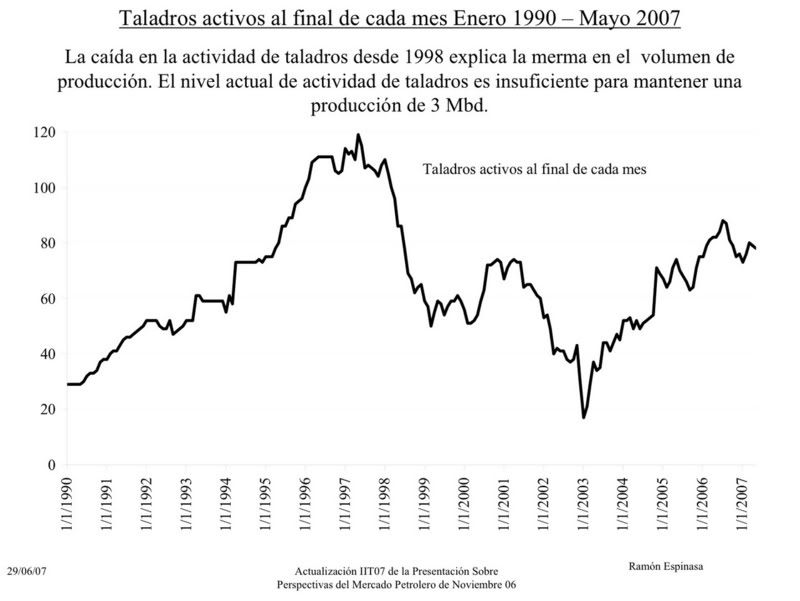
The text on this chart says that the current number of rigs is insufficient to maintain a production level of 3 million barrels of oil per day. Yet the numbers in the graph itself show that claim to be false. Looking at it we see that the current number of drilling rigs is equal to or greater than any time except the period between 1995 and 1998. From 1995 to 1998 Venezuela was very rapidly expanding oil production (ie not just maintaining production but increasing it by about 200,000 barrels of daily production every year) to well over three million barrels per day. Given that Venezuela is not currently expanding production (because it has to stay within its OPEC quota) it does not need that number of rigs.
However note that from 1999 to 2002, when the country was simply maintaining production and not expanding it, the number of rigs was actually somewhat LESS than it is today. With around 80 rigs Venezuela managed to keep production levels of around 3 MBPD from 1999 to 2002 so why should that number of rigs all of the sudden be inadequate? The fact is, comparing the number of rigs to what Venezuela’s needs are we see that today’s number of rigs is perfectly adequate to maintain production levels.
Should Venezuela want to significantly expand production, as its long term business plan calls for, it would need more rigs, but given OPEC quotas that is not likely to happen any time soon.
So what we see is the only thing mysterious here is why Ms. Ronsenberg hasn’t better informed herself on these issues and even looked closely at the number presented by her favored sources before giving what is clearly an erroneous analysis.
Continuing on with her “PDVSA is in trouble” theme she then quotes one analyst as saying PDVSA production has been going down for the past couple of years – presumably because of mismanagement and missing oil rigs! Of course, that Venezuela might have intentionally reduced its production to meet cuts in its OPEC quotas over the past two years completely is completely beyond her. Yet that is precisely what happened. Once again, the fact that she barely seems to realize that OPEC exists and what Venezuela’s relationship with it is makes it almost impossible for her to get much of anything right in this article.
As Ms. Rosenberg clearly wasn’t doing any independent verification of facts and was relying on the fired PDVSA managers for most of her information I had to wonder when she was going to get to the biggest two canards surrounding the Venezuelan oil industry – that PDVSA is no longer transparent and that its oil production is much less than what it says it is. I didn’t have to wait long.
First she starts with “[PDVSA] has become less and less transparent”. She goes on to say:
One thing I’ve always wondered about this whole transparency discussion is if a company publishes financial statements and no one bothers to read them does it really do much for transparency? The reason I pose that question is because, as will become clear shortly, Ms. Rosenberg obviously did not read any of PDVSA’s financial statements.
It should be noted that all of PDVSA’s financial statements, both the ones posted on the SEC web site and the ones now referenced on PDVSA’s own web-site are audited by an outside auditing firm which is an affiliate of KPMG. In fact, here is a copy of one with only “basic figures”:

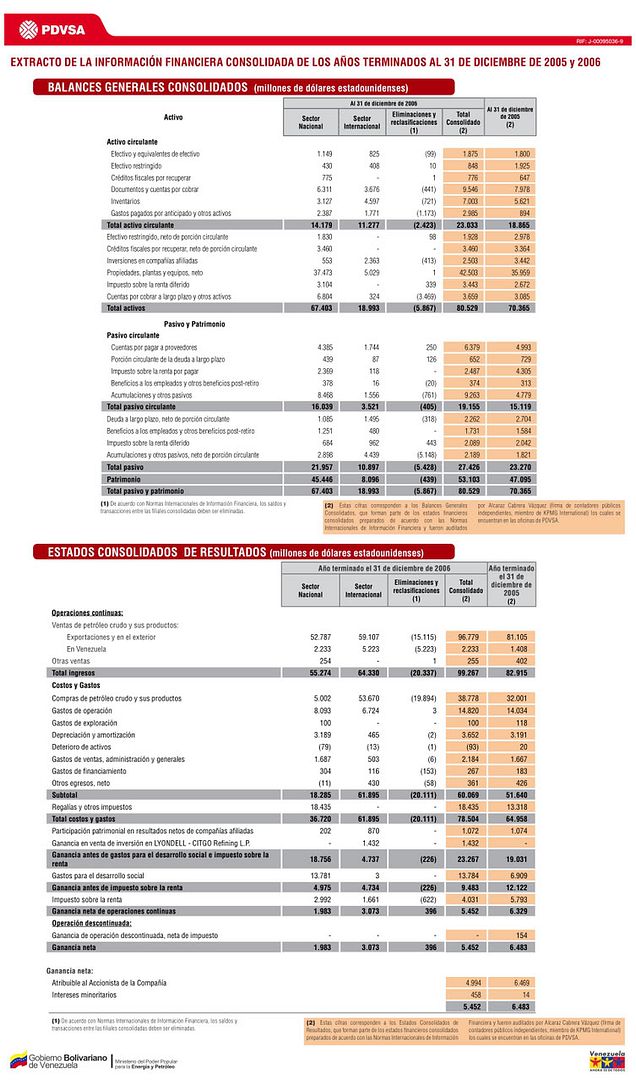
On page one the AUDITED financial statement clearly points out that Venezuelan oil production last year was 3.25 million barrels per day. So it is not just PDVSA “claming” this, its audited financial statements say that is what it is.
Of course some contrarian may say – “but production numbers aren’t audited so maybe they are lying about those”. Yet even if it were true that production numbers weren’t audited it wouldn’t matter. From the financial statement we see that Venezuela got approximately $53 billion in revenue from exporting oil and oil products. Using the knowledge that Venezuelan oil averaged $55 per barrel last year and that there are 365 days in the year we can see that Venezuela had to be exporting approximately 2,600,000 barrels per day. Add in the 650,000 that even Rosenberg acknowledges is consumed domestically and we, very mysteriously, arrive at Venezuela producing 3,250,000 barrels of oil per day.
Will the contrarians now tell us that the auditors don’t audit the money either? If only Ms. Rosenberg had read PDVSA’s financial report and done some elementary arithmetic she could have caught the Venezuelan government telling the truth.
The reality of the situation is that if you don’t believe that Venezuela is producing over 3 MBPD of oil then you really do have a big mystery on your hands, namely where is all the money coming from?
In fact, if she was on the ball she could have picked up on this from Mr. Espinasa’s own reports on Venezuela’s oil industry. You see, he gives numbers showing declining Venezuelan oil production and that match the numbers Ms. Rosenberg uses:

From that it follows that exports have also declined and are only about 1.6 million barrels per day as Espinasa shows in the next chart.
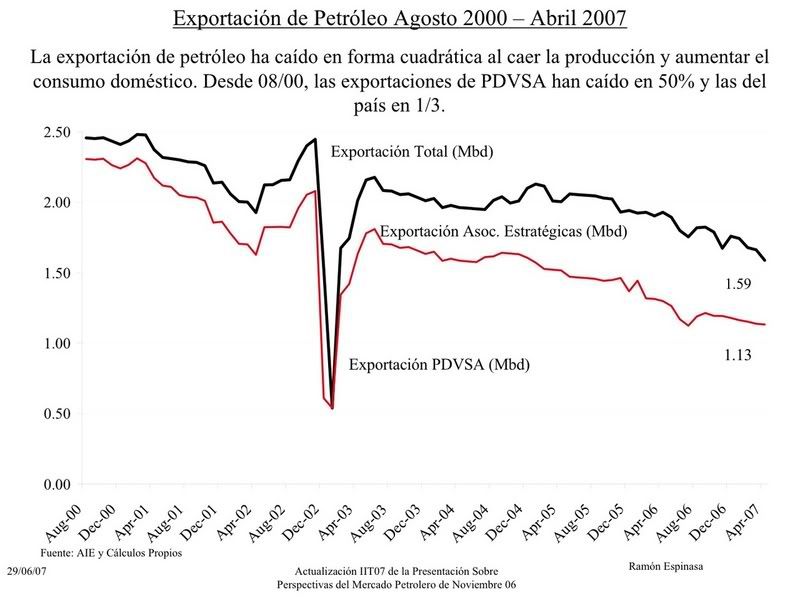
Of course we have no idea where these numbers come from, they certainly aren’t coming from any audited financial statements. But that is not the point as there is a much more fundamental problem with them. Witness the following chart which is two slides later in the very same presentation by Espinasa (the entire presentation can be found here):

In this chart Espinasa readily admits that in 2006 Venezuela exported $60 billion dollars worth of oil (for those of you wonder why it is higher than the $53 billion on PDVSA’s financial statement it is because Espinasa’s numbers include the non-PDVSA portion of the Orinoco Belt production which would not be counted in the PDVSA financial statements – yet another nuance of the Venezuelan oil industry beyond Rosenberg’s grasp).
The reason I show this slide is because it completely blows his earlier slides on production and exports out of the water. A couple of quick calculations will quickly show anyone interested that Venezuela had to export far, far more than 1.6 million barrels and produce far more than 2.4 million barrels to bring in that much money. It really is just simple arithmetic involving nothing more sophisticated than multiplication and division.
So never mind that the Venezuelan numbers are both audited and internally consistent. The numbers the PDVSA doubters present, and that Rosenberg is apparently gullible enough to believe, are not only not audited (in fact I have never once heard how these numbers are come up with) they aren’t even internally consistent. The production and revenue numbers people like Espinasa give can’t possibly be right because they completely contradict each other. Yet Rosenberg is so unquestioning she can’t be bothered to spend a few minutes on a calculator and figure out that her primary source is clearly leading her astray.
The fact that she didn’t read any of the financial statements becomes even more obvious when she says:
It is true that PDVSA took on debt earlier this year and the wisdom of that is debatable. But had she bothered to read any of PDVSA’s financial statements (which can be found here) she would have found out that PDVSA had at least $7 billion in debt early this decade – hardly “very little”.
In fact, she really should have known that the whole reason PDVSA had to file financial statements with the U.S. Security Exchange Commission in the first place was because they had large amounts of debt held by bondholders in the U.S. It was only because under Chavez they paid those debts off that they could stop filing with the SEC after 2004.
I guess it is too late now but knowing that might have prevented her from letting the bald faced lie that they didn’t have any debt before go unchallenged. But repeating other people’s lies is what happens when you don’t do your homework. (BTW, she also repeats the lie that Ramirez said that people who don’t support Chavez can’t work at PDVSA – I guess we can assume she didn’t watch the video of that either even though it can be easily found on YouTube).
Comically, she goes on to claim that Venezuela “once” had a savings fund for oil revenues with $6 billion in it that now only hold $700 million. I guess you could be forgiven if you thought that some previous government saved up money and Chavez then blew the wad. But in reality the “once” was earlier this decade after Chavez boosted oil revenues and paid into it – the fund didn’t exist at all before Chavez and previous governments left him not a single dollar of saved up oil revenues.
Further, the money was spent when the PDVSA managers shut down the oil industry and put the economy in a full blown depression. If you can’t spend the money in that situation, when can you spend it?
Ms. Rosenberg’s indolence and failure to dig out facts aside, the Venezuelan oil industry is doing just fine. Venezuela is producing exactly what it should be to maximize revenues and the revenues themselves are way up, confirming that sticking to OPEC quotas is indeed a wise policy. No one, including Ms. Rosenberg, need cry for PDVSA, it really couldn’t be better as any one who carefully and honestly looks at the facts will see.
Unfortunately, her being distracted by the unfounded allegations about PDVSA sidetracked her from what could have made for a very interesting article – how exactly should Venezuela’s oil income be used. She does correctly note that large oil windfalls often dampen other economic activity – especially manufacturing and exports. Given that Venezuela clearly is suffering from some of those problems a good discussion on that topic would have been very welcome.
Unfortunately, she never returns to that topic. Rather she goes off on a tangent yet again and discusses whether Venezuela would be better off if oil extraction were done by private companies that were then heavily taxed. That is, should Venezuela then let private companies produce the oil rather than having a state owned like PDVSA do it? Personally, I think it is a moot point because PDVSA was nationalized well before Chavez came to office and after a long struggle it is finally now a well run company. If it is not broken, why fix it?
Also, there are possible downsides to allowing private companies control production. First, they aren’t going to do it for free – they are going to want a profit, probably a big profit. In fact in both the Orinoco belt and in older oil fields were they were also allowed in the private oil companies were robbing Venezuela blind. Even if the government is effective in negotiating a very high level of royalties and taxes the companies are going to expect to make a decent profit and that stands in contrast to a state owned model where the government gets all the profits. So it would only make sense economically to allow in private companies if the gains in efficiencies would be greater than the profits that are surrendered to them.
A second, and possibly bigger obstacle to allowing in private firms, is that they are generally not going to be receptive to having to reduce output to stay within OPEC quotas. It is certainly not lost on the Venezuelan government that they have been sued by private companies precisely for cutting production due to OPEC quota reductions.
Lastly, switching to a private oil company model does nothing to solve the very real problems that Ms. Rosenberg noted oil producing countries can have. An overvalued currency, undermining of local industry, graft, and all the other problems of the “petro-state” would still exist.
The reason is those problems have nothing to do with who takes the oil out of the ground. Rather they result from the government controlling all the money. In Rosenberg’s model where private companies extract the oil but the vast majority of the money still goes to the government you would quite likely have all the same problems.
That Ms. Rosenberg missed this point shows she really hasn’t thought much of any of this through clearly. So in fairness to people like Sosa-Pietri and Giusti, let me at least point out that they do claim to have a definitive solution to those problems – giving ownership shares of PDVSA to every Venezuelan citizen so that they receive the oil rents directly rather than having them pass through a potentially corrupt and inefficient government.
Despite a promising beginning where Ms Rosenberg accurately identified some of the pitfalls facing oil producing countries the article proved to be a major disappointment. This again goes back to her just not having gotten straight what the fundamental issues and debates around Venezuelan oil policy have been.
Again, the biggest dispute has always been what Venezuela should with all the oil it sits atop – should it intentionally limit how much oil it produces, in conjunction with OPEC, hoping to maximize revenues by boosting prices, or should they maximize production and maybe if prices do well anyways also have high revenues?
In fact, both schemes have been tried for approximately a decade: the latter for much of the 90s and the former during the entire time Chavez has been in office.
The production maximization experiment went badly as quota busting led to steady declines in prices which in turn greatly reduced revenues and sent the Venezuelan economy into a downward spiral. In contrast, the strategy of working with OPEC to limit production and defend prices has proven spectacularly successful with Venezuelan revenues having increased many times over. As far as I this blogger is concerned that debate is all but over with the defending prices model having proven itself to be vastly superior and more profitable. It is hard to see how any honest person can argue otherwise after the experience of the past 20 years.
The second argument is what should Venezuela do with the oil monies it gets: should it spend them on imports, should it invest them, should it give each citizen a check, or should it save up for a rainy day? This is a very real debate that has yet to be settled. For example, while I certainly consider their oil policy to be a major success I think many of their other macro-economic policies are anything but wise.
Although Rosenberg notes some of the problems Venezuela faces and how important it is for future generations that something be done to develop the rest of the economy she abandons this most important discussion and never returns to it.
We quite possibly get a hint of why when she says of Venezuela: “It has become a rich country of poor people”. That is utterly false. For all its oil Venezuela is still very poor. A couple thousand bucks per person, which is what Venezuela gets from oil in its best years, doesn’t go very far.
Only if a way can be found to leverage Venezuela’s oil riches to bring about comprehensive economic development can the country ever cease to be poor. But Rosenberg fails to discuss at all how this might be done and her article therefore winds up contributing nothing to peoples understanding of Venezuela, its oil industry, and the problems it faces as it struggles to develop.
|
Fortunately for Venezuela there really isn’t much more to this dichotomy than some pretty poor reporting. Case in point is “The perils of Petrocracy” in today’s New Times.
The first problem with the article is it is a fairly large bait and switch. It starts off as if it is going to be about the economic problems that countries with lots of oil run into and whether or not oil is a help or hindrance for their economic development. That is certainly an important topic. Yet the article gets side tracked into a discussion of the current state of the Venezuelan oil industry and never gets back to the subject of oil and development. But more on that later.
Unfortunately even though the article is mainly about the Venezuelan oil industry it doesn’t even prove very informative about that as the author, Tina Rosenberg, clearly failed to do her homework. She doesn’t bother to familiarize herself with all the readily available information on the subject and when she talks to the former overlords of the Venezuelan oil industry – who just maybe have an axe to grind – she doesn’t even know enough to ask the right questions or bring up key facts which might cast doubt on their assertions.
For starters there is this complete misunderstanding of what the dispute over the oil industry is really all about:
In the 1990s, Venezuela’s state oil company was a sleek machine, an excellent exploiter of oil, well fed on its own profits. It floated above society, unmoored from the problems of the average citizen. Today, oil money feeds and educates poor neighborhoods. The purpose of the national oil company is not to produce more oil, but to produce Bolivarian socialism. These are two very different ways to handle a nation’s oil resource. Can either model show poor countries how to convert natural resources into sustained wealth? Few questions in economic policy are more important today.
Here Ms. Rosenberg has completely confused the issues of what Venezuela should do to develop economically – i.e., how should it use the oil revenues that it gets – with the other very hotly debated topic of how Venezuela should maximize it oil income – i.e. how should Venezuela use the abundant oil it has in the ground to generate the greatest amount of income. The dispute over how the state owned oil company, PDVSA, should be used is NOT between pumping more oil or “producing Bolivarian socialism” but between pumping more oil just to have a bigger oil company or pumping less oil to have higher oil prices and hopefully more revenue for Venezuela.
In other words should PDVSA try to become as big as Exxon-Mobil, even if it generates less revenue for the country in the process, or should Venezuela be a good member of the OPEC cartel and restrict oil output to increase the amount of money they get for their oil?
That debate, the REAL debate regarding oil policy, has been going on in Venezuela for 40 years now. Before Chavez came to office those who just wanted to grow PDVSA had power. They were notorious OPEC quota busters (Venezuela was producing 700,000 barrels per day over its quota when Chavez came to office). Their quota busting policies helped push oil prices steadily lower in the 1990s and in turn sent Venezuela’s economy into a tailspin.
So unaware of this is Ms. Rosenberg is she never once mentions either OPEC quotas or the effect that the level of Venezuelan oil production might have on prices. Prices are presumably set only by outside forces that Venezuela has no control over at all and so it doesn’t even merit thinking about or discussing. In this, she accepts, either consciously or unconsciously, the most fundamental tenet of the anti-Chavez former managers of Venezuela’ oil – that as Venezuelan production levels have no impact on prices and prices should therefore be taken as a given, the only logical policy is to maximize the amount of oil produced. That many other Venezuelans thought differently, including the ones who made Venezuela a founding member of OPEC, completely escaped Ms. Rosenberg’s notice.
Chavez himself of course knew all about those debates and was a firm believer in working with OPEC to restrict production, boost prices, and maximize oil revenues, NOT production. Upon coming to office in 1999 he immediately cut Venezuelan output sharply to conform with OPEC quotas and in the process almost tripled oil prices and greatly increased Venezuela’s oil revenues. The old guard PDVSA management never accepted this and almost immediately set about trying to overthrow his government.
That Ms. Rosenberg doesn’t even understand what the heart of the dispute is – should the country maximize oil production or should it maximize oil revenues and its corralarly of should it ignore OPEC quotas or follow them religiously – leads the entire article astray. Moreover, by not appreciating how contentious this debate has been she doesn’t take sufficient care to verify peoples assertions on the what Venezuela’s industry is like.
For example, she clearly swallows the erroneous assertion that Venezuela was a well run oil producing machine before Chavez and is now much less efficient hook, line and sinker. She bases this belief not on any actual analysis but probably on getting most of her information from the PDVSA management that was fired by Chavez.
In reality, before Chavez PDVSA was highly corrupt and it was that corruption which led them to want to maximize production.
In the early 1990s when PDVSA embarked on a course of ignoring OPEC increasing production, profits be damned, it was led by Andres Sosa Pietri. In his book “Petroleo y Poder” (a book that should be read by anyone with even a passing interest in the Venezuelan oil industry but was obviously not read by Ms. Rosenberg) he lays out his beliefs that PDVSA should be run free of any control by the state, that production should be maximized, and that Venezuela should leave OPEC.
He also, in a bout of honesty, notes that his family owned the Constructora Nacional de Valvulas (the National Valve Fabricator) which made all the pumps and valves used by PDVSA as it expanded production. This is a stunning conflict of interest (and it should be noted that the shareholders of a private corporation would never tolerate such a clear conflict of interests) and makes it more than obvious why he would want to maximize production – the country might make less money but all the new PDVSA investment would, and did, make his family wealthy.
Later the company was run by Luis Giusti. He believed in ignoring OPEC and maximizing production just as much as Sosa Pietri did. He also believed in opening up Venezuelan oil exploitation to private firms whose long term, favorable contracts would, as Bernard Mommer (another key observer of the Venezuelan oil industry who Ms. Rosenberg has apparently never hear of and never read) noted, help force Venezuela to leave OPEC.
Mr. Giusti was no less self-serving in his policies than was Sosa Pietri. During his tenure most of PDVSA’s finance and administrative functions were spun off into a private for profit company called Intesa which Mr. Giusti had direct financial interests. Of course, the bigger PDVSA became the more profits there would be for Intesa and for Mr. Giusti himself. So once again we see that PDVSA’s policy of hyper growth most likely grew out of a desire not to help Venezuela but rather to help the top management of the company enrich itself.
So this morass of insider dealing and corruption is what we are supposed to believe was a “sleek machine” and an “excellent exploiter of oil”? The reality is this quota busting, production maximizing company only made its management wealthy while the revenues for the country continually shrank.
Ms. Rosenberg accepts much of the rest of the old PDVSA management’s propoganda. For example, while noting that Citgo may have been used to move oil profits out of Venezuela through transfer pricing (for a discussion of how that worked see Mommer’s article Subervise Oil) she then gushes that both the Citgo purchase and the opening up of production of the heavy oils in the Orinoco Belt were “brilliant business decisions”!
Let’s see how “brilliant” these business decisions were. First, Citgo was purchased without bothering to negotiate a double taxation treaty with the U.S.. This was then used as an excuse for Citgo never to pay any dividends to Venezuela and in fact prior to Chavez coming to office Citgo never paid any. So Venezuela had a multi-billion dollar investment which was not giving it any profits. It is hard for me to see the “brilliance” of that.
Rosenberg then buys into the spurious argument that Citgo refineries would help assure a market for Venezuelan oil. She is apparently unaware that many of the Citgo refineries, and other refineries that Venezuela bought in places like Germany, have never actually refined any Venezuelan oil.
Worse still, this betrays a lack of understanding of basic economics. If Citgo refineries were somehow specially suited to refine Venezuelan oil, which some of them are, they would be buying Venezuelan oil no matter who owned them. In fact, Venezuela recently sold off one of its Citgo refineries in the U.S (one that cost Venezuela $750 million in losses by being forced to sell it under priced oil) and guess what? - it still buys its oil from Venezuela. Venezuela no more needs to own Citgo to sell its oil in the United States than Sony needs to own Best Buy or Circuit City in order to sell its televisions in the U.S.
The Orinoco Belt oil production, which was ramped up to 600,000 barrels of oil per day was the other half of this “brilliant” decision. Yet it only appears brilliant to Rosenberg because she completely ignores the issue of OPEC quotas. If there were no quotas and if Venezuelan output had no effect on prices then maybe having this additional oil revenue would make sense.
However, Venezuela does have an OPEC quota which limits what it can produce. For that reason this Orinoco oil, which is expensive to produce and fetches a lower price on world markets making its profit margin much lower then other Venezuelan oils, displaces other oil. That is, if Venezuela’s quota is 3 million barrels and the Orinoco oil is 600,000 then they have to cut back their other, more profitable production, back to 2.4 million barrels. No normal person would view cutting back on the production of more profitable oil to make way for LESS profitable oil a “brilliant business decision”.
Of course, the real brilliance of the decision from the perspective of people like Sosa Pietri and Giusti was that turning over oil production to private companies would force Venezuela out of OPEC as private companies would never agree to cut their output to stay within quotas. In fact, the co-owner of the Citgo refinery that Venezuela just sold, Lyondell, sued Venezuela in 2002 for cutting back its oil allotment due to OPEC quotas!! If Ms. Rosenberg had bothered to read Sosa-Pietri’s and Giusti’s writings on these subjects she would have known this. But once again she is so unaware of what the issues are she is incapable of even asking the right questions and categorizes as “brilliant” decisions which in fact were disastrous for Venezuelan.
Rosenberg then veers into talking about how “PDVSA” is in trouble”. According to Rosenberg one prime example of “trouble” is “the mystery of the missing drilling rigs”. Venezuelan oil production is falling, she claims, because Venezuela supposedly does not have enough drilling rigs to drill for oil and maintain production which naturally declines as old wells run dry.
To analyze this mystery we fortunately have at our disposal a chart of oil rig numbers in Venezuela prepared by one of Rosenberg’s main sources, the anti-Chavez former PDVSA economist Ramon Espinasa:

The text on this chart says that the current number of rigs is insufficient to maintain a production level of 3 million barrels of oil per day. Yet the numbers in the graph itself show that claim to be false. Looking at it we see that the current number of drilling rigs is equal to or greater than any time except the period between 1995 and 1998. From 1995 to 1998 Venezuela was very rapidly expanding oil production (ie not just maintaining production but increasing it by about 200,000 barrels of daily production every year) to well over three million barrels per day. Given that Venezuela is not currently expanding production (because it has to stay within its OPEC quota) it does not need that number of rigs.
However note that from 1999 to 2002, when the country was simply maintaining production and not expanding it, the number of rigs was actually somewhat LESS than it is today. With around 80 rigs Venezuela managed to keep production levels of around 3 MBPD from 1999 to 2002 so why should that number of rigs all of the sudden be inadequate? The fact is, comparing the number of rigs to what Venezuela’s needs are we see that today’s number of rigs is perfectly adequate to maintain production levels.
Should Venezuela want to significantly expand production, as its long term business plan calls for, it would need more rigs, but given OPEC quotas that is not likely to happen any time soon.
So what we see is the only thing mysterious here is why Ms. Ronsenberg hasn’t better informed herself on these issues and even looked closely at the number presented by her favored sources before giving what is clearly an erroneous analysis.
Continuing on with her “PDVSA is in trouble” theme she then quotes one analyst as saying PDVSA production has been going down for the past couple of years – presumably because of mismanagement and missing oil rigs! Of course, that Venezuela might have intentionally reduced its production to meet cuts in its OPEC quotas over the past two years completely is completely beyond her. Yet that is precisely what happened. Once again, the fact that she barely seems to realize that OPEC exists and what Venezuela’s relationship with it is makes it almost impossible for her to get much of anything right in this article.
As Ms. Rosenberg clearly wasn’t doing any independent verification of facts and was relying on the fired PDVSA managers for most of her information I had to wonder when she was going to get to the biggest two canards surrounding the Venezuelan oil industry – that PDVSA is no longer transparent and that its oil production is much less than what it says it is. I didn’t have to wait long.
First she starts with “[PDVSA] has become less and less transparent”. She goes on to say:
The company used to publish a standard annual report, but after 2004 it stopped filing its annual reports to the U.S. Securities and Exchange Commission. In recent years it has released only a page or two of basic figures, with no breakdowns or auditors’ notes. When Pdvsa does release information, some of it is of questionable credibility. Even the most fundamental operational fact — how much oil Venezuela produces — is subject to debate. In 1997, Venezuela produced 3.3 million barrels per day of crude oil. Today, Pdvsa claims the country produces the same amount, but independent sources, including OPEC, say that figure is too high; OPEC puts Venezuela’s production at 2.4 million barrels a day last year.
One thing I’ve always wondered about this whole transparency discussion is if a company publishes financial statements and no one bothers to read them does it really do much for transparency? The reason I pose that question is because, as will become clear shortly, Ms. Rosenberg obviously did not read any of PDVSA’s financial statements.
It should be noted that all of PDVSA’s financial statements, both the ones posted on the SEC web site and the ones now referenced on PDVSA’s own web-site are audited by an outside auditing firm which is an affiliate of KPMG. In fact, here is a copy of one with only “basic figures”:


On page one the AUDITED financial statement clearly points out that Venezuelan oil production last year was 3.25 million barrels per day. So it is not just PDVSA “claming” this, its audited financial statements say that is what it is.
Of course some contrarian may say – “but production numbers aren’t audited so maybe they are lying about those”. Yet even if it were true that production numbers weren’t audited it wouldn’t matter. From the financial statement we see that Venezuela got approximately $53 billion in revenue from exporting oil and oil products. Using the knowledge that Venezuelan oil averaged $55 per barrel last year and that there are 365 days in the year we can see that Venezuela had to be exporting approximately 2,600,000 barrels per day. Add in the 650,000 that even Rosenberg acknowledges is consumed domestically and we, very mysteriously, arrive at Venezuela producing 3,250,000 barrels of oil per day.
Will the contrarians now tell us that the auditors don’t audit the money either? If only Ms. Rosenberg had read PDVSA’s financial report and done some elementary arithmetic she could have caught the Venezuelan government telling the truth.
The reality of the situation is that if you don’t believe that Venezuela is producing over 3 MBPD of oil then you really do have a big mystery on your hands, namely where is all the money coming from?
In fact, if she was on the ball she could have picked up on this from Mr. Espinasa’s own reports on Venezuela’s oil industry. You see, he gives numbers showing declining Venezuelan oil production and that match the numbers Ms. Rosenberg uses:

From that it follows that exports have also declined and are only about 1.6 million barrels per day as Espinasa shows in the next chart.

Of course we have no idea where these numbers come from, they certainly aren’t coming from any audited financial statements. But that is not the point as there is a much more fundamental problem with them. Witness the following chart which is two slides later in the very same presentation by Espinasa (the entire presentation can be found here):

In this chart Espinasa readily admits that in 2006 Venezuela exported $60 billion dollars worth of oil (for those of you wonder why it is higher than the $53 billion on PDVSA’s financial statement it is because Espinasa’s numbers include the non-PDVSA portion of the Orinoco Belt production which would not be counted in the PDVSA financial statements – yet another nuance of the Venezuelan oil industry beyond Rosenberg’s grasp).
The reason I show this slide is because it completely blows his earlier slides on production and exports out of the water. A couple of quick calculations will quickly show anyone interested that Venezuela had to export far, far more than 1.6 million barrels and produce far more than 2.4 million barrels to bring in that much money. It really is just simple arithmetic involving nothing more sophisticated than multiplication and division.
So never mind that the Venezuelan numbers are both audited and internally consistent. The numbers the PDVSA doubters present, and that Rosenberg is apparently gullible enough to believe, are not only not audited (in fact I have never once heard how these numbers are come up with) they aren’t even internally consistent. The production and revenue numbers people like Espinasa give can’t possibly be right because they completely contradict each other. Yet Rosenberg is so unquestioning she can’t be bothered to spend a few minutes on a calculator and figure out that her primary source is clearly leading her astray.
The fact that she didn’t read any of the financial statements becomes even more obvious when she says:
Pdvsa is also taking on debt. The company had very little debt until 2006, but this year it has borrowed $12.5 billion. While raising cash through debt offerings can be fiscally sound, and many companies do so, critics contend that Pdvsa is issuing bonds for the wrong reasons. “Their debts are low, but they didn’t have any before,” says José Guerra, formerly chief of the research department of the Central Bank, who left in disagreement about Chávez’s economic policies. “Other oil countries are getting rid of debt. And what is the debt going for? Their spending on exploration is almost nothing. They are taking on debt to have a party.”
It is true that PDVSA took on debt earlier this year and the wisdom of that is debatable. But had she bothered to read any of PDVSA’s financial statements (which can be found here) she would have found out that PDVSA had at least $7 billion in debt early this decade – hardly “very little”.
In fact, she really should have known that the whole reason PDVSA had to file financial statements with the U.S. Security Exchange Commission in the first place was because they had large amounts of debt held by bondholders in the U.S. It was only because under Chavez they paid those debts off that they could stop filing with the SEC after 2004.
I guess it is too late now but knowing that might have prevented her from letting the bald faced lie that they didn’t have any debt before go unchallenged. But repeating other people’s lies is what happens when you don’t do your homework. (BTW, she also repeats the lie that Ramirez said that people who don’t support Chavez can’t work at PDVSA – I guess we can assume she didn’t watch the video of that either even though it can be easily found on YouTube).
Comically, she goes on to claim that Venezuela “once” had a savings fund for oil revenues with $6 billion in it that now only hold $700 million. I guess you could be forgiven if you thought that some previous government saved up money and Chavez then blew the wad. But in reality the “once” was earlier this decade after Chavez boosted oil revenues and paid into it – the fund didn’t exist at all before Chavez and previous governments left him not a single dollar of saved up oil revenues.
Further, the money was spent when the PDVSA managers shut down the oil industry and put the economy in a full blown depression. If you can’t spend the money in that situation, when can you spend it?
Ms. Rosenberg’s indolence and failure to dig out facts aside, the Venezuelan oil industry is doing just fine. Venezuela is producing exactly what it should be to maximize revenues and the revenues themselves are way up, confirming that sticking to OPEC quotas is indeed a wise policy. No one, including Ms. Rosenberg, need cry for PDVSA, it really couldn’t be better as any one who carefully and honestly looks at the facts will see.
Unfortunately, her being distracted by the unfounded allegations about PDVSA sidetracked her from what could have made for a very interesting article – how exactly should Venezuela’s oil income be used. She does correctly note that large oil windfalls often dampen other economic activity – especially manufacturing and exports. Given that Venezuela clearly is suffering from some of those problems a good discussion on that topic would have been very welcome.
Unfortunately, she never returns to that topic. Rather she goes off on a tangent yet again and discusses whether Venezuela would be better off if oil extraction were done by private companies that were then heavily taxed. That is, should Venezuela then let private companies produce the oil rather than having a state owned like PDVSA do it? Personally, I think it is a moot point because PDVSA was nationalized well before Chavez came to office and after a long struggle it is finally now a well run company. If it is not broken, why fix it?
Also, there are possible downsides to allowing private companies control production. First, they aren’t going to do it for free – they are going to want a profit, probably a big profit. In fact in both the Orinoco belt and in older oil fields were they were also allowed in the private oil companies were robbing Venezuela blind. Even if the government is effective in negotiating a very high level of royalties and taxes the companies are going to expect to make a decent profit and that stands in contrast to a state owned model where the government gets all the profits. So it would only make sense economically to allow in private companies if the gains in efficiencies would be greater than the profits that are surrendered to them.
A second, and possibly bigger obstacle to allowing in private firms, is that they are generally not going to be receptive to having to reduce output to stay within OPEC quotas. It is certainly not lost on the Venezuelan government that they have been sued by private companies precisely for cutting production due to OPEC quota reductions.
Lastly, switching to a private oil company model does nothing to solve the very real problems that Ms. Rosenberg noted oil producing countries can have. An overvalued currency, undermining of local industry, graft, and all the other problems of the “petro-state” would still exist.
The reason is those problems have nothing to do with who takes the oil out of the ground. Rather they result from the government controlling all the money. In Rosenberg’s model where private companies extract the oil but the vast majority of the money still goes to the government you would quite likely have all the same problems.
That Ms. Rosenberg missed this point shows she really hasn’t thought much of any of this through clearly. So in fairness to people like Sosa-Pietri and Giusti, let me at least point out that they do claim to have a definitive solution to those problems – giving ownership shares of PDVSA to every Venezuelan citizen so that they receive the oil rents directly rather than having them pass through a potentially corrupt and inefficient government.
Despite a promising beginning where Ms Rosenberg accurately identified some of the pitfalls facing oil producing countries the article proved to be a major disappointment. This again goes back to her just not having gotten straight what the fundamental issues and debates around Venezuelan oil policy have been.
Again, the biggest dispute has always been what Venezuela should with all the oil it sits atop – should it intentionally limit how much oil it produces, in conjunction with OPEC, hoping to maximize revenues by boosting prices, or should they maximize production and maybe if prices do well anyways also have high revenues?
In fact, both schemes have been tried for approximately a decade: the latter for much of the 90s and the former during the entire time Chavez has been in office.
The production maximization experiment went badly as quota busting led to steady declines in prices which in turn greatly reduced revenues and sent the Venezuelan economy into a downward spiral. In contrast, the strategy of working with OPEC to limit production and defend prices has proven spectacularly successful with Venezuelan revenues having increased many times over. As far as I this blogger is concerned that debate is all but over with the defending prices model having proven itself to be vastly superior and more profitable. It is hard to see how any honest person can argue otherwise after the experience of the past 20 years.
The second argument is what should Venezuela do with the oil monies it gets: should it spend them on imports, should it invest them, should it give each citizen a check, or should it save up for a rainy day? This is a very real debate that has yet to be settled. For example, while I certainly consider their oil policy to be a major success I think many of their other macro-economic policies are anything but wise.
Although Rosenberg notes some of the problems Venezuela faces and how important it is for future generations that something be done to develop the rest of the economy she abandons this most important discussion and never returns to it.
We quite possibly get a hint of why when she says of Venezuela: “It has become a rich country of poor people”. That is utterly false. For all its oil Venezuela is still very poor. A couple thousand bucks per person, which is what Venezuela gets from oil in its best years, doesn’t go very far.
Only if a way can be found to leverage Venezuela’s oil riches to bring about comprehensive economic development can the country ever cease to be poor. But Rosenberg fails to discuss at all how this might be done and her article therefore winds up contributing nothing to peoples understanding of Venezuela, its oil industry, and the problems it faces as it struggles to develop.
|
